Issue date: 8 December
From the Royal Mail website:
Celebrating the Lunar New Year of the Tiger, this Generic sheet features specially designed labels and incorporates 20 ‘Firework’™ stamps. 

[press release]
Royal Mail Reveals Christmas Stamps For 2021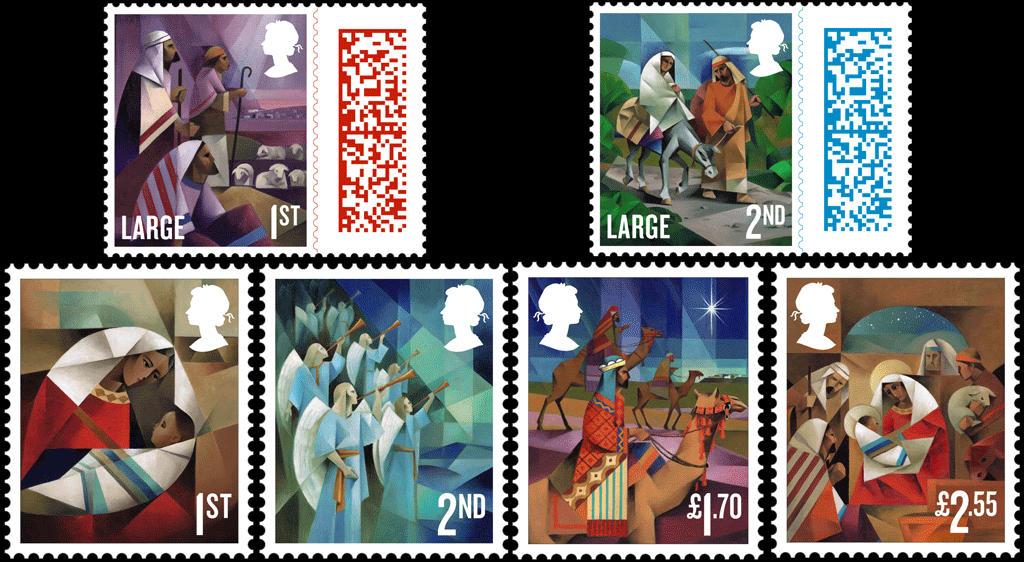
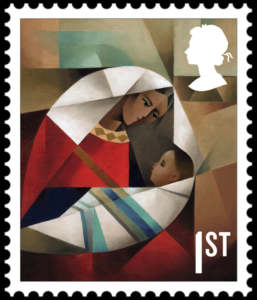 Royal Mail has revealed its Christmas 2021 stamps, featuring scenes of the Nativity, exclusively illustrated by the internationally renowned artist, Jorge Cocco.
Royal Mail has revealed its Christmas 2021 stamps, featuring scenes of the Nativity, exclusively illustrated by the internationally renowned artist, Jorge Cocco.
The illustrations warmly reflect the Biblical story of the Nativity from the Annunciation through to the journey of the Magi and the birth of Christ.
The six designs, portraying the Nativity, are reflective of Cocco’s modern style of painting – ‘sacrocubism’ – illustrating sacred events through post-cubist art.
Cocco’s work has won numerous awards and been acquired by important collectors. His work has been exhibited by 16 museums throughout the world.
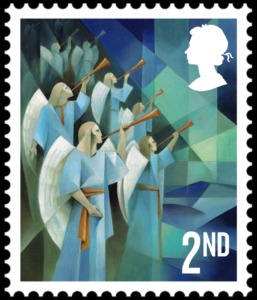 Royal Mail also worked with Dr Andrew Davison Starbridge Associate Professor in Theology and Natural Sciences at the University of Cambridge on the stamp issue.
Royal Mail also worked with Dr Andrew Davison Starbridge Associate Professor in Theology and Natural Sciences at the University of Cambridge on the stamp issue.
David Gold, Director of External Affairs & Policy, Royal Mail, said: “For many, the launch of our annual Christmas stamps marks the start of their festive planning. We hope that people will appreciate these beautiful illustrations of the Christmas Story, and that they will be encouraged to post their cards and parcels early this year.”
This year a limited number of Christmas stamps will feature barcodes. The addition will ensure that each barcoded stamp can be uniquely identified, which will pave the way for innovative customer services in the future.
The stamps are on sale now and will be available at www.royalmail.com/christmas2021, by phone on 03457 641 641 and in 7,000 Post Offices across the UK.
Not mentioned in the press release are a minisheet featuring eight stamps (two each of the barcoded ones)…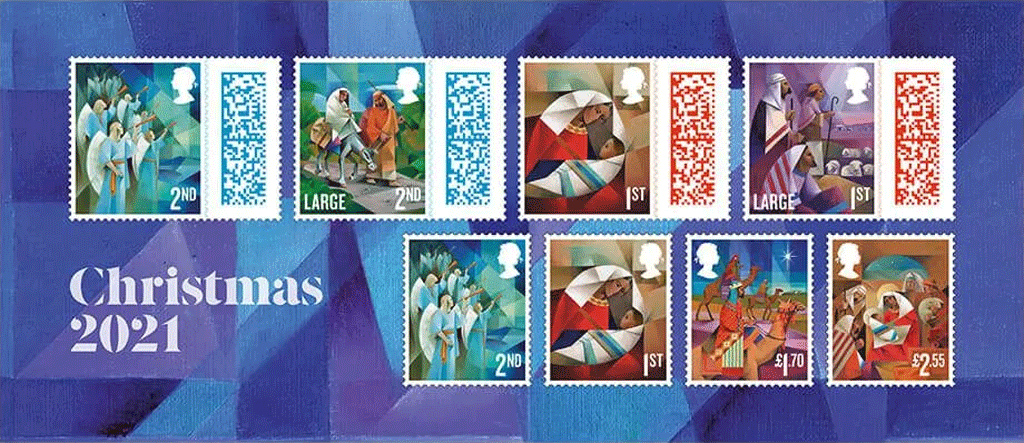
…and a “Collectors Sheet:” Twenty Christmas 2021 stamps set against a beautifully illustrated backdrop of four angels. It includes eight Second Class, eight First Class, two £1.70 and two £2.55 stamps from the Christmas 2021 issue. 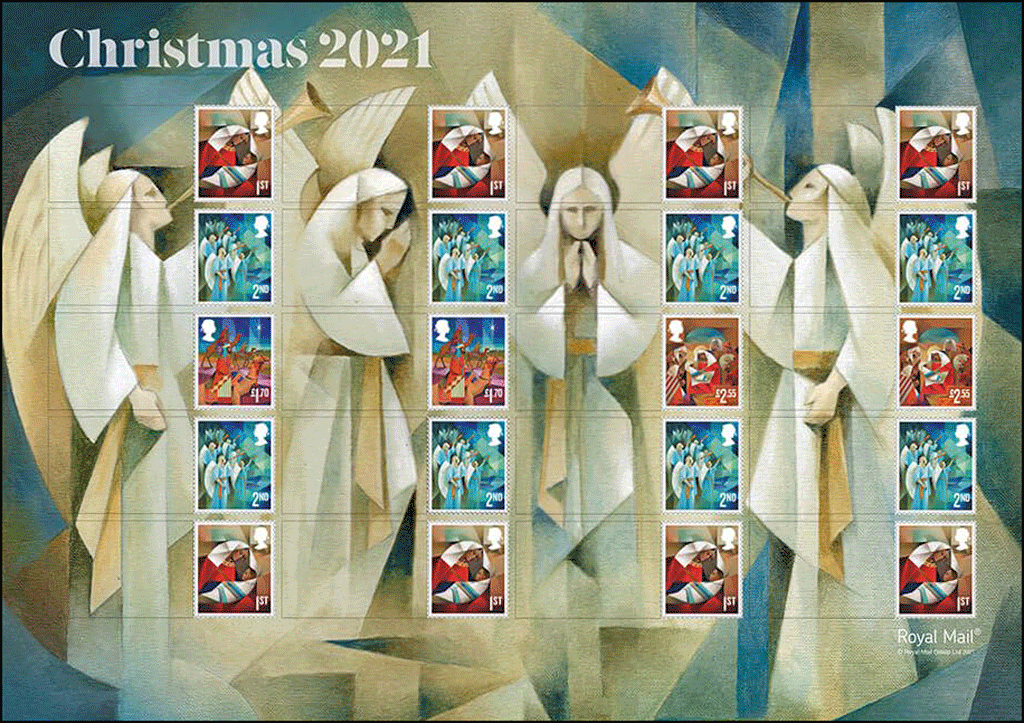 The first day covers for the stamps and the minisheet are available with two different cancels: Tallents House and Bethlehem, Llandeilo, postmarks.
The first day covers for the stamps and the minisheet are available with two different cancels: Tallents House and Bethlehem, Llandeilo, postmarks. 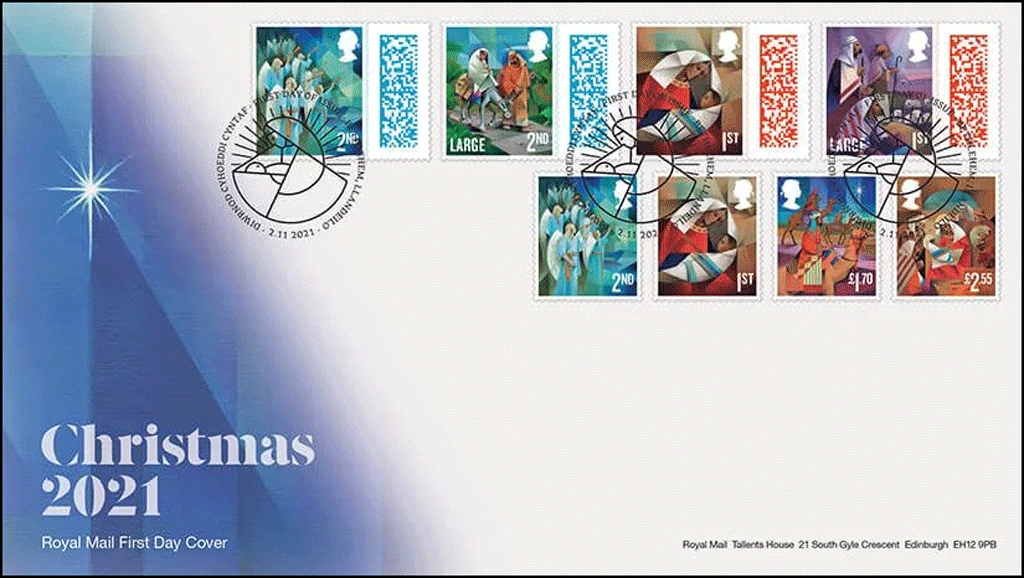
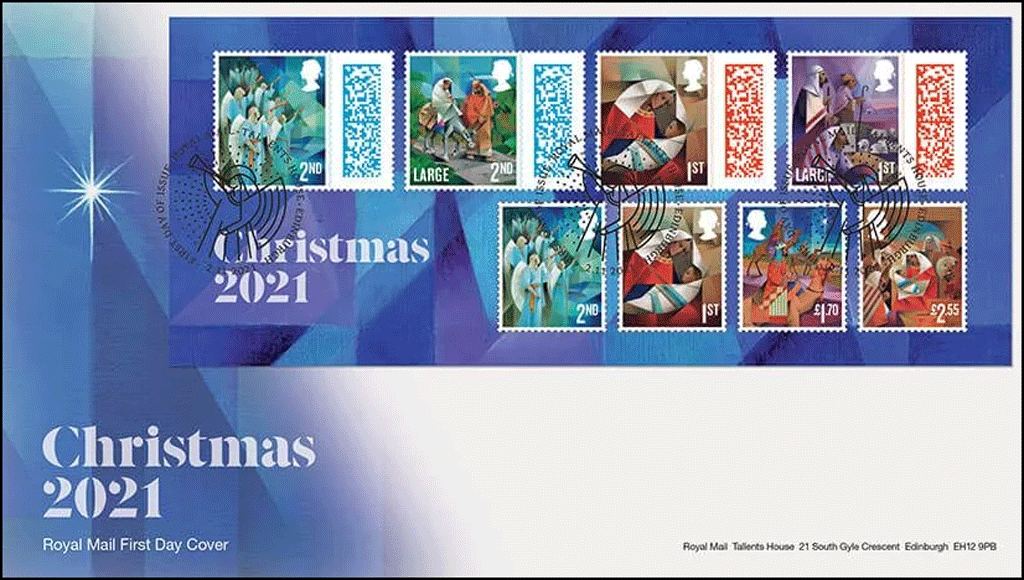 Also available are postcards and a presentation pack.
Also available are postcards and a presentation pack.
[press release]
Royal Mail Reveal Images of Eight New Stamps That Celebrate the 150th Anniversaries of the Formation of the Rugby Football Union and the First International Match Between England and Scotland In 1871
Royal Mail has revealed images of eight stamps that celebrate the 150th anniversaries of 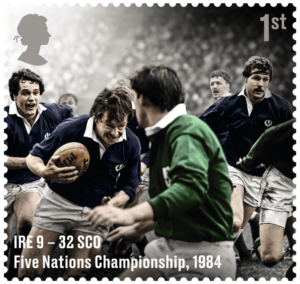 the formation of the Rugby Football Union (RFU) and the first international match between England and Scotland in 1871.
the formation of the Rugby Football Union (RFU) and the first international match between England and Scotland in 1871.
Rugby legends from the men’s and women’s game feature on the stamps including: JPR Williams; Emily Scarratt; Sophie Spence; Roy Laidlaw; Kim Littlejohn; Simon Geoghegan; Melissa Berry; and Jonny Wilkinson.
Images shown on the stamps are from:
Also featured on one of the stamps is Vicky Macqueen, MBE – who won 34 caps for England – who is pictured making the tackle on Wales’ Melissa Berry during a match in the 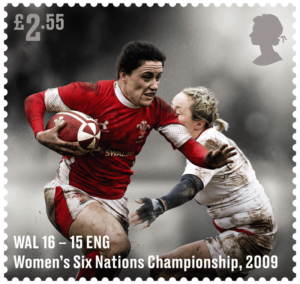 2009 Women’s Six Nations Championship.
2009 Women’s Six Nations Championship.
David Gold, Director of External Affairs & Policy, said: “The sport of rugby continues to evolve today and is becoming an ever more inclusive sport – with almost three million women players across the world – increased diversity and inclusivity has seen the culture of the game change, both on and off the field. These stamps are a fitting way to mark Rugby Union’s long and extraordinary history.”
Royal Mail worked closely with all four Rugby Union Home Nations’ governing bodies on selecting the images to be included in the stamp issue.
The full set of eight stamps, available in a Presentation Pack, retails at £12.40. The stamps 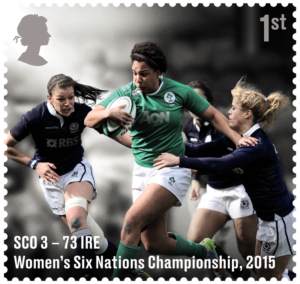 and a range of collectible products are available to pre-order from today (5 October) at www.royalmail.com/rugbyunion and go on general sale from 19 October.
and a range of collectible products are available to pre-order from today (5 October) at www.royalmail.com/rugbyunion and go on general sale from 19 October.
Rugby Football Union
The popularity of the ‘rugby’ style of football and corresponding need for universal laws saw 21 English clubs meet in London on 26 January 1871 to form the Rugby Football Union. The first set of laws was approved later that year, not long after England met Scotland’s challenge in the first rugby international. England have won what is now the Six Nations Championship 29 times outright, with ten shared victories, and the Grand Slam (beating every other nation in the competition) 13 times. England are the only northern hemisphere team to have won the World Cup, beating Australia in 2003.
First International
While England and Scotland had already unofficially met playing ‘football’ rules, most 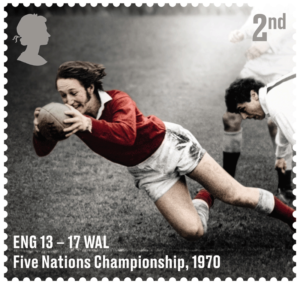 ‘football’ clubs north of the border played a game far more similar to modern rugby and were determined to test national sporting strengths along these lines. On 27 March 1871, the countries met at Raeburn Place, Edinburgh, and after an epic contest, Scotland prevailed by one goal to nil. Angus Buchanan scored the crucial ‘try’ (grounding the ball over the opponents’ goal line), which afforded William Cross the chance to kick the ball over the crossbar and between the posts – at the time, the only way to score a point.
‘football’ clubs north of the border played a game far more similar to modern rugby and were determined to test national sporting strengths along these lines. On 27 March 1871, the countries met at Raeburn Place, Edinburgh, and after an epic contest, Scotland prevailed by one goal to nil. Angus Buchanan scored the crucial ‘try’ (grounding the ball over the opponents’ goal line), which afforded William Cross the chance to kick the ball over the crossbar and between the posts – at the time, the only way to score a point.
The Women’s Game
No area of rugby union has seen greater growth in recent years, so much so that few clubs in countries where the sport is long established do not now have strong women’s sections, while the proportion of women playing is noticeably high in countries in which the 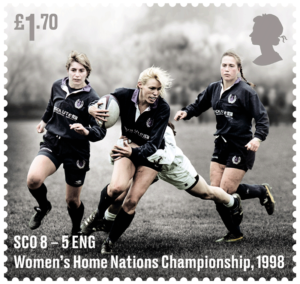 sport is becoming established. The first Women’s Home Nations Championship was staged in 1996 and the first official Women’s Rugby World Cup in 1998: New Zealand, due to host the next World Cup in 2022, have been world champions five times, England twice and the United States once. There are now approaching three million female players across the world.
sport is becoming established. The first Women’s Home Nations Championship was staged in 1996 and the first official Women’s Rugby World Cup in 1998: New Zealand, due to host the next World Cup in 2022, have been world champions five times, England twice and the United States once. There are now approaching three million female players across the world.
Scottish Rugby Union
Founded in 1873 and based since 1925 at Murrayfield Stadium in Edinburgh, the SRU played a leading role in the development of the modern game and is responsible for all Scotland’s national sides, as well as the country’s domestic leagues and competitions. Having beaten England in the first international played, Scotland have gone on to win what is now the Six Nations Championship 15 times outright and have shared the title nine times. They have won the Grand Slam three times, most recently in 1990, and competed in every World Cup, with a 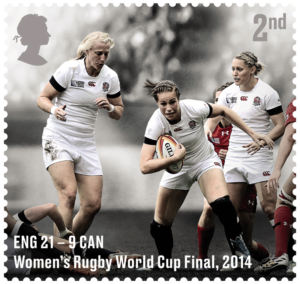 best-placed finish of fourth.
best-placed finish of fourth.
Welsh Rugby Union
Since the formation of the Welsh Rugby Union in 1881, the nation has produced some of the world’s finest players. The national side was arguably the best in the world in the years running up to the First World War, and again in the 1970s. Wales have won what is now the Six Nations Championship 28 times outright, with 12 shared victories, and the Grand Slam (beating every other country) on 12 occasions, most recently in 2019. They have competed in every World Cup, reaching the semi-finals three times.
Irish Rugby Football Union
Ireland played their first international against England in 1875, four years before the founding of the Irish Rugby Football Union, which manages the sport across the entire 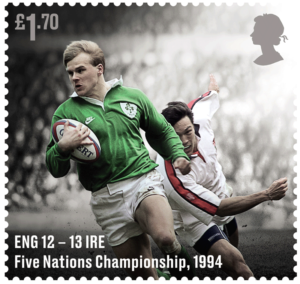 sland. Ireland, along with Scotland and Wales, were founding members of the Home Nations Championship, the predecessor of the Six Nations Championship, which they have won 14 times outright, with nine shared titles. They have also won three Grand Slams and in recent years have become one of the strongest teams in world rugby, combining vigour and verve with physicality and commitment. Ireland have competed in all nine World Cup tournaments and missed out on the quarter finals on two occasions.
sland. Ireland, along with Scotland and Wales, were founding members of the Home Nations Championship, the predecessor of the Six Nations Championship, which they have won 14 times outright, with nine shared titles. They have also won three Grand Slams and in recent years have become one of the strongest teams in world rugby, combining vigour and verve with physicality and commitment. Ireland have competed in all nine World Cup tournaments and missed out on the quarter finals on two occasions.
Women’s Rugby World Cup Final, 2014
After defeat in three successive finals, England win the World Cup. Tries from Emily Scarratt (pictured, with ball) and Danielle Waterman secure victory.
Five Nations Championship, 1970
A victory marking the start of a glorious era in Welsh rugby for a side featuring greats like JPR Williams (pictured), Gareth Edwards and Mervyn Davies.
Women’s Six Nations Championship, 2015
Needing to win to secure the title, a rampant Ireland – with lock Sophie Spence (pictured) to the fore – ran in 11 tries to become champions.
Five Nations Championship, 1984
Scrum-half Roy Laidlaw (pictured, with ball) scored two tries as Scotland became outright winners of the Five Nations Championship for the first time since 1938.
Women’s Home Nations Championship, 1998
Led by Kim Littlejohn (pictured, far left), Scotland complete a five-year journey from novices to best team in Europe with a win that boosted the sport’s status in the country.
Five Nations Championship, 1994
Ireland upset the odds to win at Twickenham for the first time in 12 years – a brilliant try by Simon Geoghegan (pictured) inspiring a generation of outstanding players.
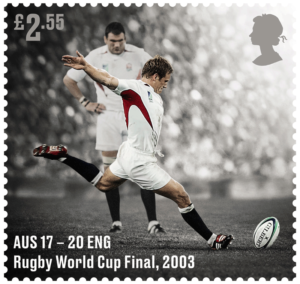 Women’s Six Nations Championship, 2009
Women’s Six Nations Championship, 2009
Non Evans kicks the winning penalty in the final minute as Wales, captained by Melissa Berry (pictured), beat England for the first time and win the Triple Crown.
Rugby World Cup Final, 2003 (above)
Jason Robinson’s try and five successful kicks from Jonny Wilkinson (pictured) see England become the first northern hemisphere country to win the World Cup.
Read VSC’s notes after the lengthy press release for more information. “Epic” may refer more to the efforts of stamp collectors who try to collect one of each!
[press release] [you can click on any image for a larger version]
Royal Mail Reveals Epic Stamp Images of the New DC Collection
Featuring Batman, His Allies, DC Super-Villains and a Special Justice League Stamp Miniature Sheet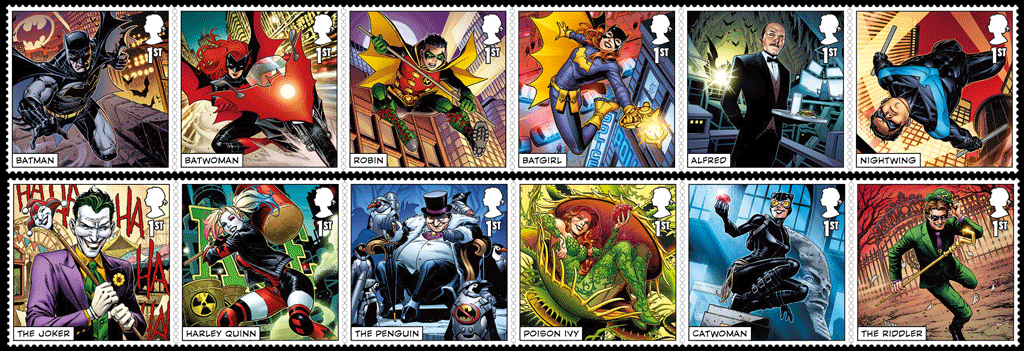
Issue Date: 17 September
Royal Mail, in partnership with Warner Bros. Consumer Products, has revealed stunning images of 18 stamps that celebrate DC and the Super Heroes & Super-Villains genre that it helped create.
The main set of 12 stamps pay tribute to the world-famous Batman, his allies and foes through the ages. 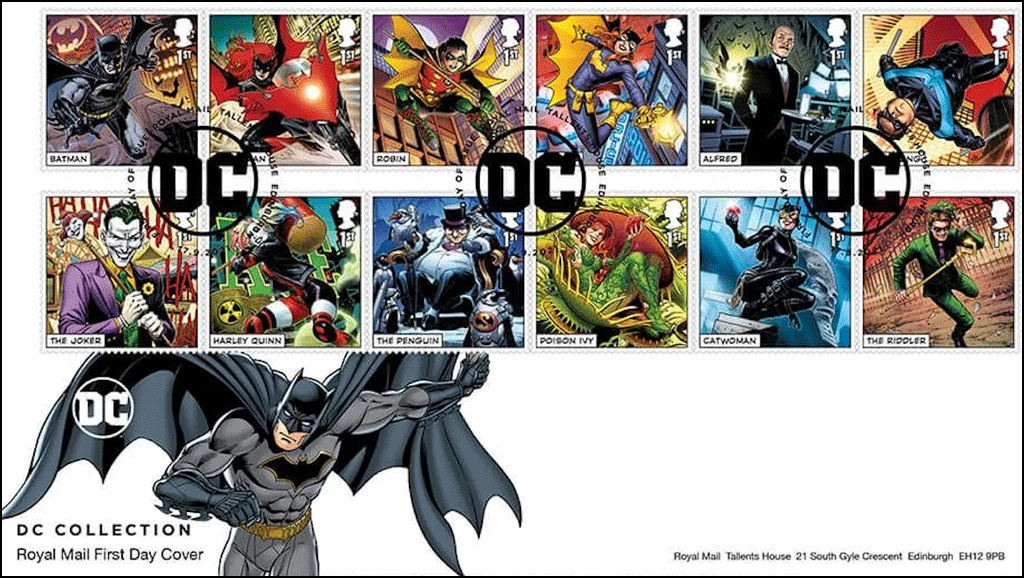 Featured on the main stamps in the set are:
Featured on the main stamps in the set are:
A further six stamps, presented in a Miniature Sheet, celebrate the Justice League – the World’s Greatest Super Heroes joining forces to protect the planet: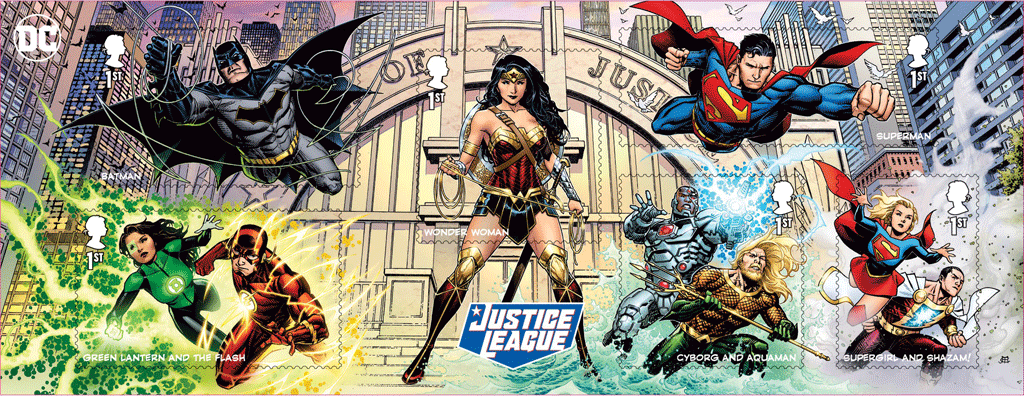
All 18 stamps have been specially commissioned for Royal Mail and illustrated by British 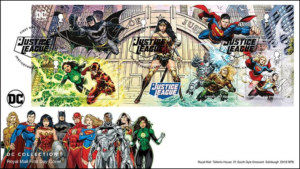 comic book artist, Jim Cheung and colourist Laura Martin.
comic book artist, Jim Cheung and colourist Laura Martin.
Matt Parkes, Director Stamps & Collectibles, Royal Mail, said: “Generations have grown up, spellbound by the adventures and the personalities of these Super Heroes and Super-Villains. These illustrations detail each character with such vivid imagery that they look ready to leap out of the stamp!”
STAMP-BY-STAMP: MAIN SET
Gotham City Allies!
Since his first appearance, Batman has built up a formidable array of ‘family’ and allies as he fights crime in the troubled streets of Gotham City. Some – such as Catwoman and 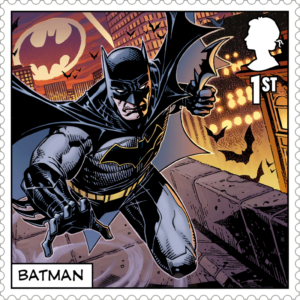 Jason Todd – tread a delicate path between heroic acts and villainy. Others – such as Robin and Batgirl – have gone on to become fully fledged members of the Batman Family, fighting both alone and alongside the Dark Knight against the city’s crazed Super-Villains
Jason Todd – tread a delicate path between heroic acts and villainy. Others – such as Robin and Batgirl – have gone on to become fully fledged members of the Batman Family, fighting both alone and alongside the Dark Knight against the city’s crazed Super-Villains
Batman
Bruce Wayne swore vengeance when his parents were gunned down in front of him. He spent his teenage years training to be a master of martial arts and the World’s Greatest Detective. On his return to Gotham City, he takes on the role of Batman to strike fear into 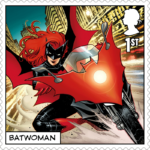 the hearts of criminals and create a more just world.
the hearts of criminals and create a more just world.
Batwoman
Kate Kane becomes Batwoman after the Dark Knight saves her life. Thanks to rigorous training, she uses her abilities to protect the innocent from crime and corruption.
Robin
Dick Grayson, Jason Todd, Tim Drake and Stephanie Brown 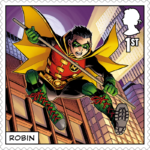 have all been Robin, but the latest is the Dark Knight’s own son – Damian Wayne. Trained in secret by his mother, Talia al Ghul, to be an assassin, Damian eventually connects with his father who takes him under his protective wing and puts his deadly skills to better use.
have all been Robin, but the latest is the Dark Knight’s own son – Damian Wayne. Trained in secret by his mother, Talia al Ghul, to be an assassin, Damian eventually connects with his father who takes him under his protective wing and puts his deadly skills to better use.
Batgirl
Barbara Gordon is a computer mastermind and a martial arts expert. She combines these skills to fight crime as Batgirl and keep Gotham City safe.
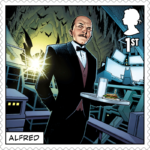 Alfred
Alfred
Alfred Pennyworth has been the man Batman trusts most in the world. He provides medical, technological and emotional support to the Dark Knight, constantly looking after his welfare and helping him reach his full potential.
Nightwing
Dick Grayson was the first Robin. After outgrowing the role, he took on the mantle of Nightwing, bringing justice to the streets of Blüdhaven.
Gotham City Foes!
Gotham City’s mean streets have given birth to a number of crazed Super-Villains. Some, such as Poison Ivy, fight for their own causes, while others seek fortune and infamy. Many, such as The Joker, are simply looking to bring ruin to those around them. Others, like Harley Quinn and Catwoman, have occasionally helped Batman and his allies. But all have had moments when they’ve brought fear and terror to Gotham City… even though it may 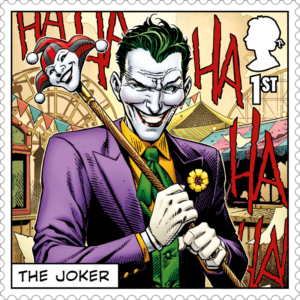 not have taken long for Batman to thwart their evildoings.
not have taken long for Batman to thwart their evildoings.
The Joker
The Joker is Batman’s complete opposite. He is a ruthless criminal whose maddening plans have brought death and destruction to Gotham City while hurting those closest to the Dark Knight. The Joker’s origins are shrouded in mystery, but he has developed an obsession with Batman as the two are locked in a never-ending duel.
Harley Quinn
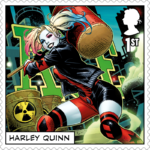 Harley Quinn once had an obsessive love affair with The Joker. Now she’s gone solo and has even become something of an anti-hero – albeit in her own chaotic way.
Harley Quinn once had an obsessive love affair with The Joker. Now she’s gone solo and has even become something of an anti-hero – albeit in her own chaotic way.
The Penguin
Operating from his nightclub, the Iceberg Lounge, and obsessed with birds, Oswald Cobblepot is better known as The Penguin and controls much of Gotham City’s criminal underworld.
Poison Ivy
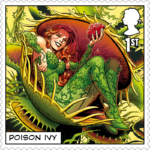 Botanist Pamela Isley gained the power to control flora and became an eco-terrorist, fighting to save her beloved plant life from humankind’s destruction.
Botanist Pamela Isley gained the power to control flora and became an eco-terrorist, fighting to save her beloved plant life from humankind’s destruction.
Catwoman
Selina Kyle is the criminal who stole Batman’s heart. She is one of the best jewel thieves in the world but also protects those close to her with a feline ferocity.
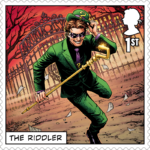 The Riddler
The Riddler
Edward Nygma is better known as The Riddler, a criminal genius obsessed with puzzles. He loves leaving clues to his crimes – clues usually only someone as smart as he can solve.
MINIATURE SHEET
Wonder Woman
Wonder Woman is an Amazonian warrior beyond compare – the only thing that rivals her super-strength is her compassion and belief in others.
Superman
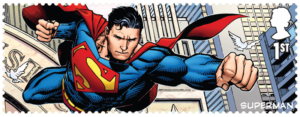 The last survivor of Krypton, Superman protects his adopted home of Earth as he battles for truth, justice and hope – shining a light on what the world can be.
The last survivor of Krypton, Superman protects his adopted home of Earth as he battles for truth, justice and hope – shining a light on what the world can be.
Batman
Bruce Wayne assumed the identity of Batman to strike fear into the hearts of criminals. He is Gotham City’s protector and the World’s Greatest Detective.
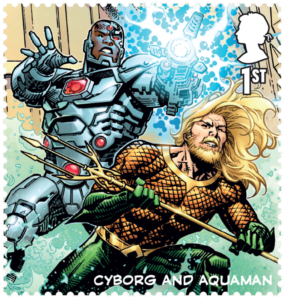 Aquaman
Aquaman
Aquaman is the half-human, half-Atlantean King of the Seven Seas. He accepts his destiny to protect both the surface world and its underwater realms from global threats.
Cyborg
When teenager Victor Stone is injured in a tragic accident, his father rebuilds him as a Cyborg – part human, part machine and all Super Hero.
Green Lantern
Jessica Cruz overcomes anxiety and fear to join the Green Lantern Corps. She uses her 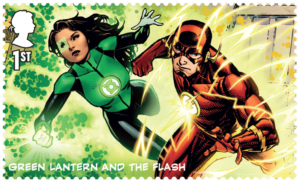 power ring to protect Earth and the universe as a part of this courageous intergalactic peacekeeping force.
power ring to protect Earth and the universe as a part of this courageous intergalactic peacekeeping force.
The Flash
The Flash is the Fastest Man Alive after a freak lightning strike connected Barry Allen to the mysterious Speed Force and opened up the possibilities of the Multiverse for all.
Supergirl
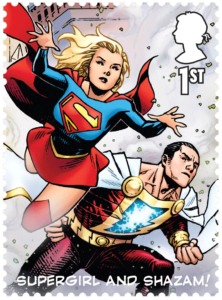 The powerful Kara Zor-El arrived on Earth as a teenager long after her cousin grew up to become Superman, but she quickly realises she can be her own positive force for justice in her new home.
The powerful Kara Zor-El arrived on Earth as a teenager long after her cousin grew up to become Superman, but she quickly realises she can be her own positive force for justice in her new home.
Shazam!
An ancient wizard bestowed teenager, Billy Batson, with magic superpowers, and now he can transform into Earth’s Mightiest Mortal by uttering one word: SHAZAM!
The full set of 18 stamps, available in a Presentation Pack, retails at £16.20. The stamps and a range of collectible products are available to pre-order from today (1 September) at www.royalmail.com/dccollection and go on general sale from 17 September 2021.
Here are the first-day postmarks, two for the “main set” and two for the minisheet: VSC’s Notes:
VSC’s Notes:
There are many more philatelic products available: Framed prints, unserviced envelopes, postcard sets, medal covers, medals by themselves, gold-plated covers, “souvenirs” (FDCs without addresses), press sheets and a prestige booklet. There are two booklets, each with two DC stamps and 4 of Her Majesty: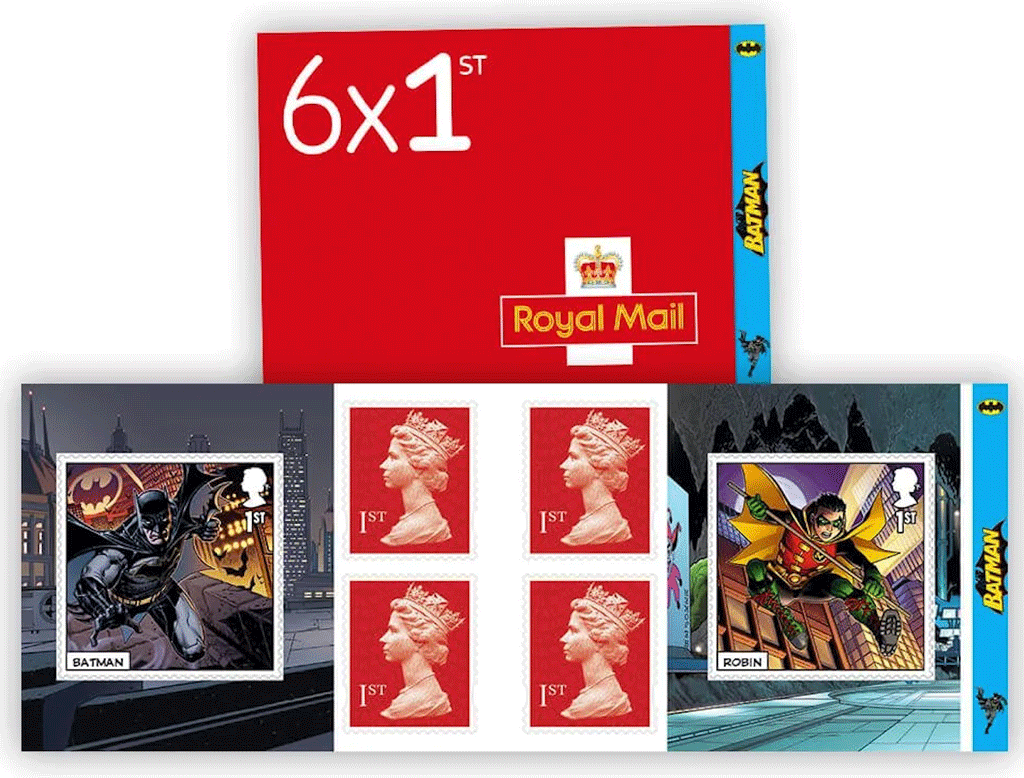 and
and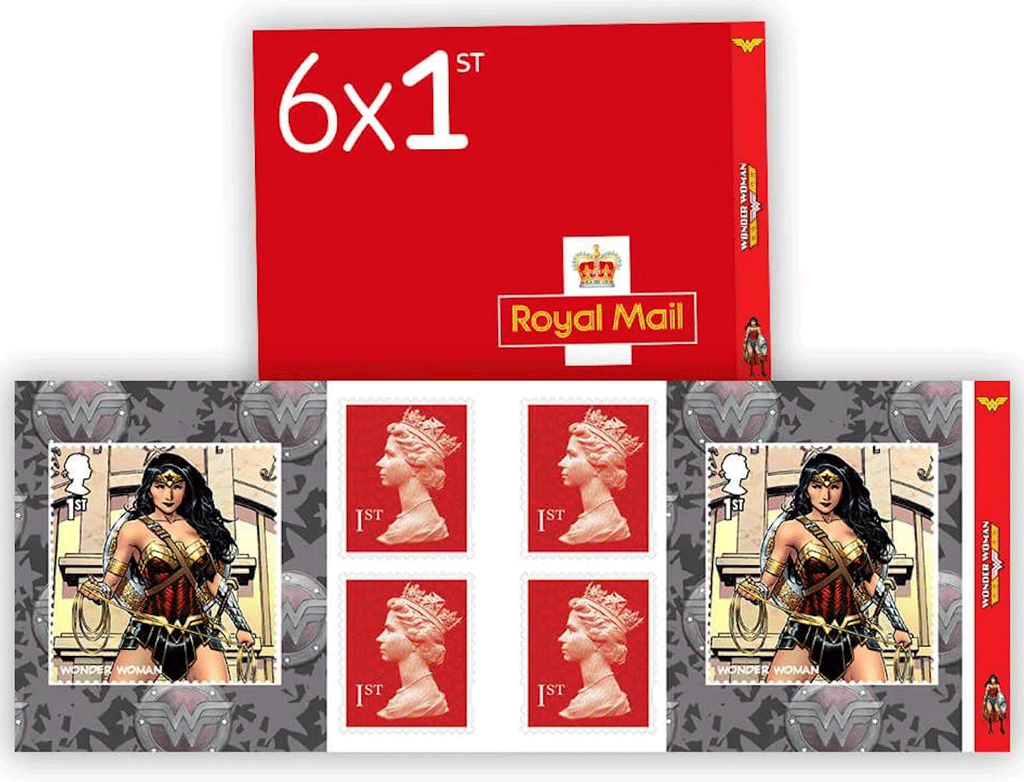 …and a prestige booklet that includes a pane only available in that product
…and a prestige booklet that includes a pane only available in that product 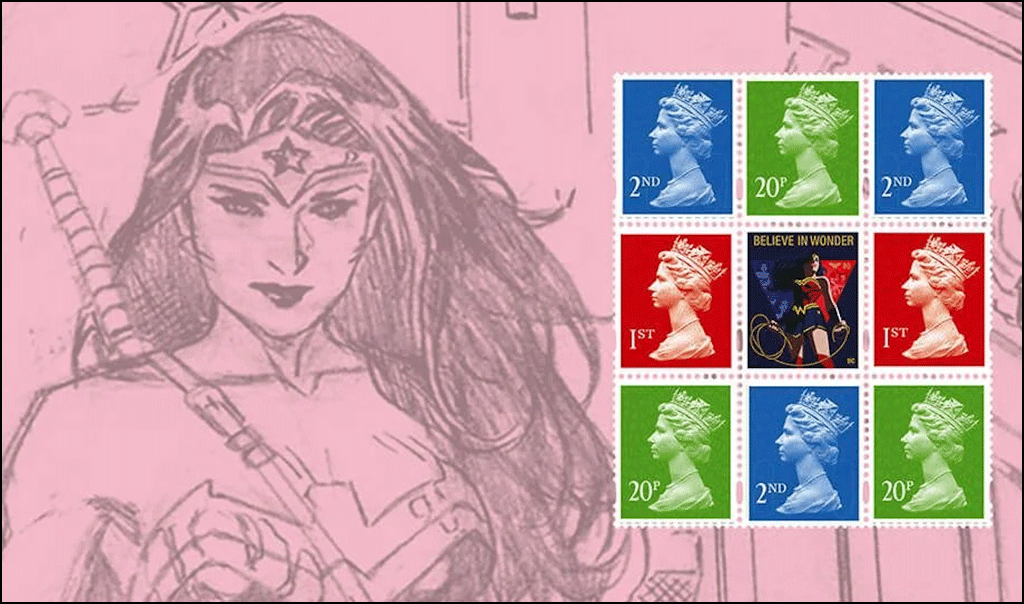 and on a first-day cover, but not separately.
and on a first-day cover, but not separately.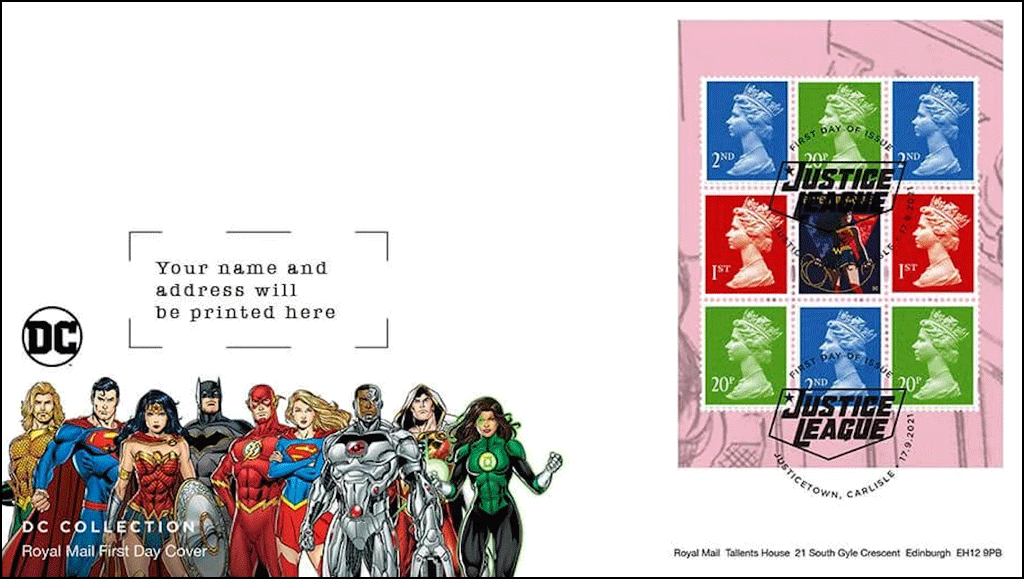 We calculate that to buy one of everything will cost nearly 1,000 pounds — £995.41 to be exact. That’s US$1,370.44 or €1,159.76! Or as they say in comic books, !!!!
We calculate that to buy one of everything will cost nearly 1,000 pounds — £995.41 to be exact. That’s US$1,370.44 or €1,159.76! Or as they say in comic books, !!!!
Stamp Images we couldn’t fit in above: 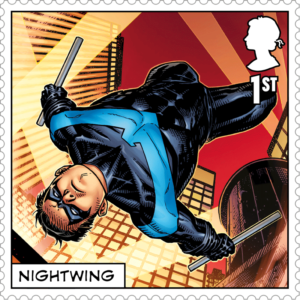
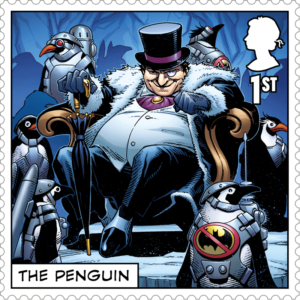
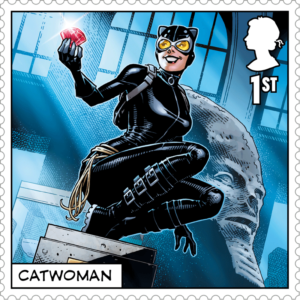
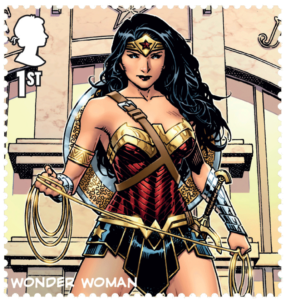
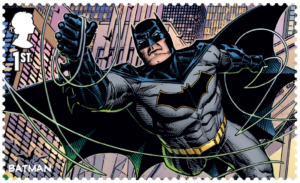 Finally, here are links to VSC material on other comic book superheroes stamps:
Finally, here are links to VSC material on other comic book superheroes stamps:
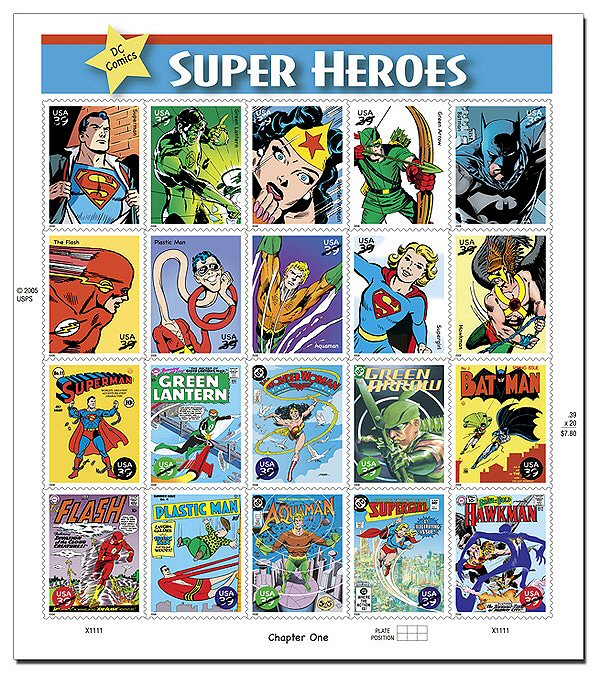
Issue Date: 2nd Sept 2021
 [press release]
[press release]
Royal Mail Issues 12 Special Stamps that Illustrate the Development of British Army Vehicles over The Decades
Royal Mail has revealed images of 12 Special Stamps that illustrate the development of British Army Vehicles over the decades.
Included are eight images featuring stunning paintings of important British Army Armoured Vehicles illustrated in action through the years since the First World War.
Seven of the eight stamps in the main set were exclusively illustrated for Royal Mail by military artist Mick Graham. Mick Graham was part of the 4th Royal Tank Regiment, serving for fifteen years, including as a Gunnery Instructor on Chieftain Tanks before turning his hand to art.
The British Army has always needed vehicles to transport food, munitions and supplies to allow soldiers to carry out their operations. For centuries, this meant the horse and wagon.
At the start of the First World War, however, breaking through trenches defended by barbed wire and machine guns required new vehicles. An innovative experimental armoured vehicle with a petrol engine, a turret for armament and tracks to cross broken ground was commissioned and nicknamed ‘Little Willie’.
Whilst this vehicle never saw combat action the innovation and experimentation which were hallmarks of its development led to the construction of the first rhomboid-shaped tanks, 49 of which first fought in September 1916. By the end of the war, Britain had developed most of the types of armoured vehicles still in service today: tank, armoured personnel carrier, self-propelled artillery and an engineer vehicle.
On the day the First World War ended, a floating tank was being trialled. Between the two world wars, the Army experimented with a fully mechanised force, including tracked scout carriers, tanks, gun tugs and trucks to ferry troops – controlled via newly effective radios.
Despite the success of the trials, the financial depression of the 1930s and the emphasis on the Royal Navy and Royal Air Force as the first line of defence meant that mechanisation was slower than the Army wanted.
At the beginning of the Second World War, the Army had 40,000 vehicles – and was the only fully mechanised force in Europe. Armoured divisions played a crucial role in mobile warfare in Europe and North Africa; Britain started the war with two of these armoured divisions and finished with eleven. Britain’s own vehicle production was supplemented by tens of thousands of trucks, jeeps and tanks from the USA, and by 1945 there were over 1.5 million vehicles in service.
The Cold War brought new requirements for Army vehicles, such as for some to be sealed against chemical and nuclear contamination, and new technologies, such as infrared or thermal imaging, enabling night-time use.
Recent campaigns have led to a range of vehicles to help patrol and protect troops and supplies against all-round attack. New developments and experimentation with digital technology are leading to the increasing fielding of remotely controlled and autonomous vehicles.
Matt Parkes, Director of Stamps & Collectibles at Royal Mail said: “These are some of the most important vehicles that have served the British Army since the First World War. Their impact both in combat and the development of armoured vehicles cannot be underestimated – and it is for this reason we mark these vehicles with a set of Special Stamps.”
Royal Mail worked closely with the Ministry of Defence on the stamp issue.
Product range at a glance:
Mk IV – 1st class
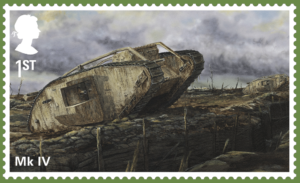 The first use of Mark I tanks on the Somme in September 1916 had mixed results, but British Commander-in-Chief General Douglas Haig saw their potential and ordered 1,000. The Mark II and III tanks were made in small quantities, but it was the Mark IV, with over 1,200 made, that saw the most use before the war’s end. Tanks were designated either ‘male’ or ‘female’, according to gun types fitted. The male Mark IV tanks had shorter six-pounder guns than on the Mark I, and the housings could be pushed into the vehicle to simplify rail movement. The eight-strong crews saw their tanks work well at the Battle of Messines in June 1917 but then flounder in mud at Passchendaele. Doubts were raised about the expense and usefulness of the tank, but the Mark IVs were to prove their worth in a mass attack by over 400 at Cambrai in November 1917.
The first use of Mark I tanks on the Somme in September 1916 had mixed results, but British Commander-in-Chief General Douglas Haig saw their potential and ordered 1,000. The Mark II and III tanks were made in small quantities, but it was the Mark IV, with over 1,200 made, that saw the most use before the war’s end. Tanks were designated either ‘male’ or ‘female’, according to gun types fitted. The male Mark IV tanks had shorter six-pounder guns than on the Mark I, and the housings could be pushed into the vehicle to simplify rail movement. The eight-strong crews saw their tanks work well at the Battle of Messines in June 1917 but then flounder in mud at Passchendaele. Doubts were raised about the expense and usefulness of the tank, but the Mark IVs were to prove their worth in a mass attack by over 400 at Cambrai in November 1917.
Matilda Mk II – 1st class
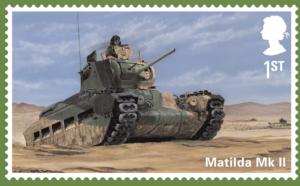 The A12 Infantry Tank, or Matilda, was the second in a series of infantry tanks that Britain put into production just before the Second World War. It was thought that three types of tank would be needed: small light tanks for reconnaissance, cruiser tanks to exploit breakthroughs and infantry tanks that would attack a defended position with the infantry. As they were more heavily armoured, infantry tanks were slower (9mph off-road), but this was considered adequate as they were to support infantry on foot. The Matilda II saw action in France in 1940, its thick armour making it impervious to the standard German 37mm anti-tank gun. Against Italian opposition in North Africa, the success of the Matilda led to it being called ‘The Queen of the Desert’. Its small turret prevented the fitting of a larger gun, so from 1942 the Matilda was relegated to use in the Far East, where the Japanese fi elded only lighter tanks.
The A12 Infantry Tank, or Matilda, was the second in a series of infantry tanks that Britain put into production just before the Second World War. It was thought that three types of tank would be needed: small light tanks for reconnaissance, cruiser tanks to exploit breakthroughs and infantry tanks that would attack a defended position with the infantry. As they were more heavily armoured, infantry tanks were slower (9mph off-road), but this was considered adequate as they were to support infantry on foot. The Matilda II saw action in France in 1940, its thick armour making it impervious to the standard German 37mm anti-tank gun. Against Italian opposition in North Africa, the success of the Matilda led to it being called ‘The Queen of the Desert’. Its small turret prevented the fitting of a larger gun, so from 1942 the Matilda was relegated to use in the Far East, where the Japanese fi elded only lighter tanks.
Churchill AVRE – 1st class
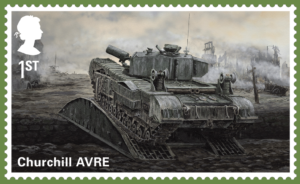 The costly failure of the raid at Dieppe in 1942 led a Canadian Royal Engineer Lieutenant JJ Denovan to propose a conversion of the Churchill infantry tank. In the turret, a spigot mortar, called the Petard, could fire a 40lb (18kg) demolition charge to a range of 200 yards. This would have a devastating effect on defensive structures or obstacles. Fixtures on the tank allowed it be adapted – to carry large loads or devices such as bobbin to lay trackway or demolition charges. The AVREs – Armoured Vehicles Royal Engineers – were issued to the 79th Armoured Division, 60 for each of three assault regiments, and they first went into action on D-Day (6 June 1944). Along with other specialised vehicles of the 79th Armoured Division, the AVREs were issued across Field Marshal Bernard Montgomery’s 21st Army Group in the North West Europe campaign, and they were considered a great success.
The costly failure of the raid at Dieppe in 1942 led a Canadian Royal Engineer Lieutenant JJ Denovan to propose a conversion of the Churchill infantry tank. In the turret, a spigot mortar, called the Petard, could fire a 40lb (18kg) demolition charge to a range of 200 yards. This would have a devastating effect on defensive structures or obstacles. Fixtures on the tank allowed it be adapted – to carry large loads or devices such as bobbin to lay trackway or demolition charges. The AVREs – Armoured Vehicles Royal Engineers – were issued to the 79th Armoured Division, 60 for each of three assault regiments, and they first went into action on D-Day (6 June 1944). Along with other specialised vehicles of the 79th Armoured Division, the AVREs were issued across Field Marshal Bernard Montgomery’s 21st Army Group in the North West Europe campaign, and they were considered a great success.
Centurion MK 9 – 1st class
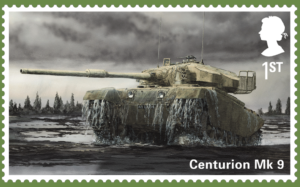 The Centurion was the British answer to the German Panther tank, developed in the Second World War. It missed seeing wartime action by a month but went on to have a long service life. The tank went through 13 marks (or models) in British Army service, showing an ability to be upgraded. It started with a 17-pounder gun, then a 20-pounder, followed by the very successful L7 105mm gun. The Rolls Royce Meteor engine gave the tank 650 horsepower – double that of most other wartime tanks. However, earlier models had a range of only 60 miles (97km), so a fuel mono-trailer was used until a larger internal tank was provided. The Mark 9 tank was an improved, rebuilt version of the Mark 7 with the L7 105mm fitted. This powerful gun became a NATO standard. The Centurion tank first saw action in the Korean War and was a huge export success, with some tanks still in service.
The Centurion was the British answer to the German Panther tank, developed in the Second World War. It missed seeing wartime action by a month but went on to have a long service life. The tank went through 13 marks (or models) in British Army service, showing an ability to be upgraded. It started with a 17-pounder gun, then a 20-pounder, followed by the very successful L7 105mm gun. The Rolls Royce Meteor engine gave the tank 650 horsepower – double that of most other wartime tanks. However, earlier models had a range of only 60 miles (97km), so a fuel mono-trailer was used until a larger internal tank was provided. The Mark 9 tank was an improved, rebuilt version of the Mark 7 with the L7 105mm fitted. This powerful gun became a NATO standard. The Centurion tank first saw action in the Korean War and was a huge export success, with some tanks still in service.
Scorpion – £1.70
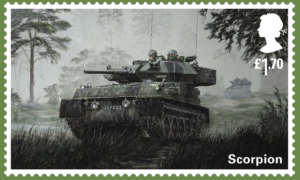 The Scorpion was part of a family of vehicles designed by Alvis in the 1960s around a number of common components. The 76mm low-velocity gun could fire a range of ammunition types and gave the small, light (8 tonnes) tank quite a punch. With aluminium armour (to keep weight down) and the Jaguar J60 4.2-litre petrol engine (the same as the E-type sports car), the tank’s top speed of 45mph made the Scorpion a difficult target to hit as a reconnaissance vehicle. Two Scorpions could fit inside a C-130 Hercules transport plane, and the original width specification was to allow it to pass through Malaysian rubber plantations. It was exported widely, and Scorpions are still in service. The vehicle saw action with the British Army in the Falklands conflict and in the First Gulf War before being withdrawn from service in 1994. Many remember the vehicle as the Action Man toy tank.
The Scorpion was part of a family of vehicles designed by Alvis in the 1960s around a number of common components. The 76mm low-velocity gun could fire a range of ammunition types and gave the small, light (8 tonnes) tank quite a punch. With aluminium armour (to keep weight down) and the Jaguar J60 4.2-litre petrol engine (the same as the E-type sports car), the tank’s top speed of 45mph made the Scorpion a difficult target to hit as a reconnaissance vehicle. Two Scorpions could fit inside a C-130 Hercules transport plane, and the original width specification was to allow it to pass through Malaysian rubber plantations. It was exported widely, and Scorpions are still in service. The vehicle saw action with the British Army in the Falklands conflict and in the First Gulf War before being withdrawn from service in 1994. Many remember the vehicle as the Action Man toy tank.
Chieftain Mk 5 – £1.70
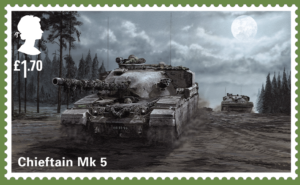 Britain decided that the priority for a main battle tank (MBT) in the Cold War was to have the best firepower and great protection; mobility was seen as less important. The stabilised 120mm gun was tremendously accurate compared to those of the wartime generation, and it was placed in a new style of mounting without a traditional mantlet (or shield). The driver had a semi-recumbent driving position, meaning that the hull could be lower, to present a smaller target. The steel armour was sloped to increase the level of protection, and additional ‘Stillbrew’ armour was added when the Soviets introduced the 125mm gun. However, the L60 engine had many reliability issues in service – a definite weakness of the tank. The tank was upgraded, running through 12 marks, after being introduced to the Army in 1967. It had some export success in the Middle East and left British service as a gun tank in the late 1990s.
Britain decided that the priority for a main battle tank (MBT) in the Cold War was to have the best firepower and great protection; mobility was seen as less important. The stabilised 120mm gun was tremendously accurate compared to those of the wartime generation, and it was placed in a new style of mounting without a traditional mantlet (or shield). The driver had a semi-recumbent driving position, meaning that the hull could be lower, to present a smaller target. The steel armour was sloped to increase the level of protection, and additional ‘Stillbrew’ armour was added when the Soviets introduced the 125mm gun. However, the L60 engine had many reliability issues in service – a definite weakness of the tank. The tank was upgraded, running through 12 marks, after being introduced to the Army in 1967. It had some export success in the Middle East and left British service as a gun tank in the late 1990s.
Challenger 2 – £1.70
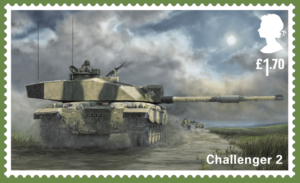 The Challenger 2 tank was initially started as a private venture by Vickers Defence, given that the Army saw the Challenger 1 (a design originally intended for the Shah of Iran) as only a stop-gap vehicle. The Challenger 2 was issued to regiments in 1998 after extensive testing. It has Chobham armour, a still-secret composite arrangement of material including ceramics that gives much greater protection than steel alone against modern weapons. When going into action, extra armour can be fitted to the tank, along with a range of other devices, such as electronic countermeasures. The Challenger 2 has a 120mm rifled gun that can fire a range of ammunition types and a thermal imaging system to allow it to fight at night. The Perkins diesel engine creates 1,200 horsepower. As with many tanks, the vehicle is being upgraded to respond to new threats and challenges on the modern battlefield.
The Challenger 2 tank was initially started as a private venture by Vickers Defence, given that the Army saw the Challenger 1 (a design originally intended for the Shah of Iran) as only a stop-gap vehicle. The Challenger 2 was issued to regiments in 1998 after extensive testing. It has Chobham armour, a still-secret composite arrangement of material including ceramics that gives much greater protection than steel alone against modern weapons. When going into action, extra armour can be fitted to the tank, along with a range of other devices, such as electronic countermeasures. The Challenger 2 has a 120mm rifled gun that can fire a range of ammunition types and a thermal imaging system to allow it to fight at night. The Perkins diesel engine creates 1,200 horsepower. As with many tanks, the vehicle is being upgraded to respond to new threats and challenges on the modern battlefield.
Ajax – £1.70
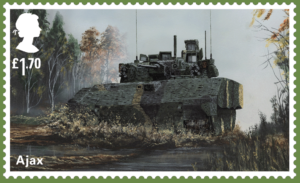 Ajax is the scouting vehicle in a new family of 589 medium-weight armoured vehicles just coming into service with the British Army. Using state-of-the-art digital technology, the Ajax has advanced intelligence, surveillance, target acquisition and reconnaissance (ISTAR) capabilities and can process and share digital information with other vehicles and higher formations. The Ajax has a turret mounting a new 40mm cased telescoped armament system (CTAS) that can fire a variety of ammunition types accurately on the move. The vehicle is protected by modular armour and a number of defensive systems to detect threats, one of which has acoustic shot detection sensors that can tell the crew the direction of incoming fire. The Ajax family consists of six variants based on a common chassis: Ajax (turreted, reconnaissance and strike vehicle), Ares (reconnaissance and armoured personnel carrier), Argus (engineer reconnaissance), Athena (command and control), Atlas (equipment support recovery) and Apollo (equipment repair).
Ajax is the scouting vehicle in a new family of 589 medium-weight armoured vehicles just coming into service with the British Army. Using state-of-the-art digital technology, the Ajax has advanced intelligence, surveillance, target acquisition and reconnaissance (ISTAR) capabilities and can process and share digital information with other vehicles and higher formations. The Ajax has a turret mounting a new 40mm cased telescoped armament system (CTAS) that can fire a variety of ammunition types accurately on the move. The vehicle is protected by modular armour and a number of defensive systems to detect threats, one of which has acoustic shot detection sensors that can tell the crew the direction of incoming fire. The Ajax family consists of six variants based on a common chassis: Ajax (turreted, reconnaissance and strike vehicle), Ares (reconnaissance and armoured personnel carrier), Argus (engineer reconnaissance), Athena (command and control), Atlas (equipment support recovery) and Apollo (equipment repair).
Stamps – Technical Details:
Number of stamps: 8
Value of Stamps: 4 x 1st and 4 x £1.70
(4 x Horizonal se-tenant pairs)
Illustrations: Mick Graham Art © Royal Mail Group Ltd 2021, except for Challenger 2 © Mick Graham Art
Design: Royal Mail Group Limited
Stamp Format: Landscape
Stamp Size: 50mm (w) x 30mm (h)
Printer : International Security Printers
Print Process: Lithography
Perforations: 14 x 14
Phosphor: Bars as appropriate
Gum: PVA
Miniature Sheet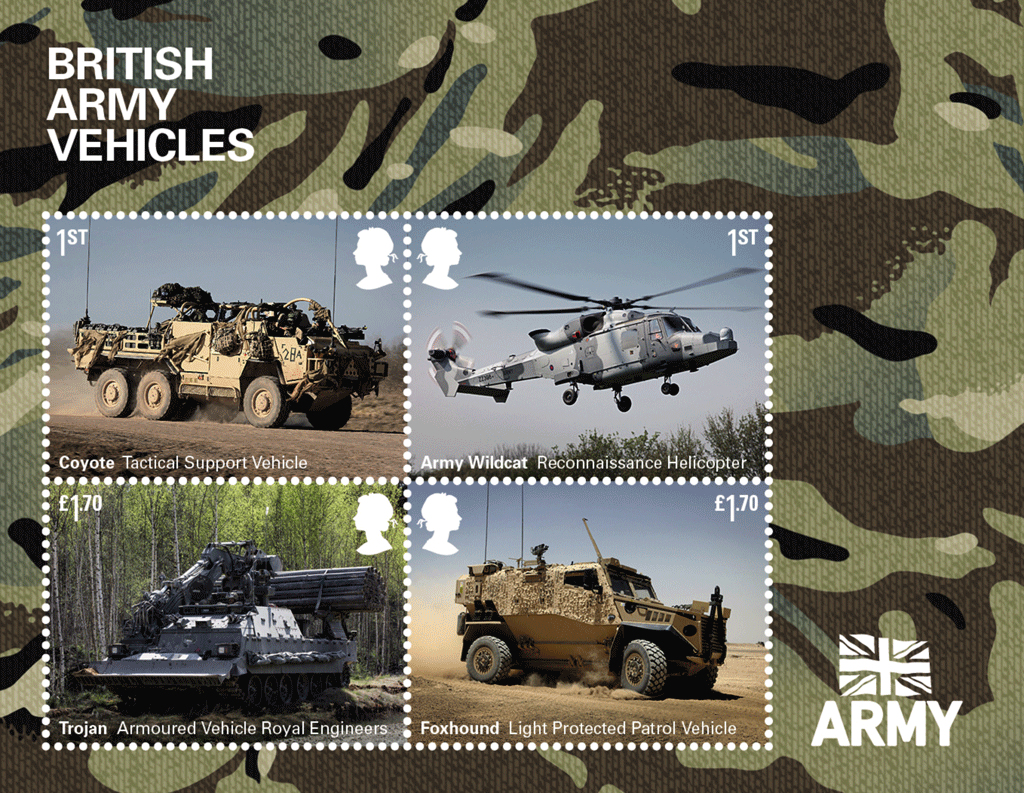 An additional four stamps featuring a range of non-combat vehicles used by the British Army
An additional four stamps featuring a range of non-combat vehicles used by the British Army
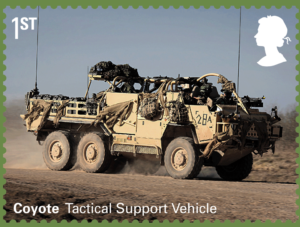 The Coyote Tactical Support Vehicle is based on the Jackal but has six wheels instead of four. The extra wheels allow it to carry a heavier load and up to five soldiers, and it can act as a support vehicle for the Jackal. The Jackal and Coyote have superb off-road capability and are used for reconnaissance and patrolling.
The Coyote Tactical Support Vehicle is based on the Jackal but has six wheels instead of four. The extra wheels allow it to carry a heavier load and up to five soldiers, and it can act as a support vehicle for the Jackal. The Jackal and Coyote have superb off-road capability and are used for reconnaissance and patrolling.
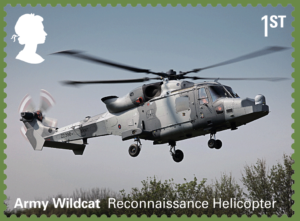 The Wildcat AH Mk 1 Reconnaissance Helicopter has a number of roles to fulfil for the Army (‘AH’ in this variant stands for ‘Army Helicopter’): airborne reconnaissance, command and control, transport of six troops or supplies, and the carrying of a sophisticated battlefield surveillance system. The Army ordered 34 Wildcats and the Royal Navy 28 in a slightly different configuration.
The Wildcat AH Mk 1 Reconnaissance Helicopter has a number of roles to fulfil for the Army (‘AH’ in this variant stands for ‘Army Helicopter’): airborne reconnaissance, command and control, transport of six troops or supplies, and the carrying of a sophisticated battlefield surveillance system. The Army ordered 34 Wildcats and the Royal Navy 28 in a slightly different configuration.
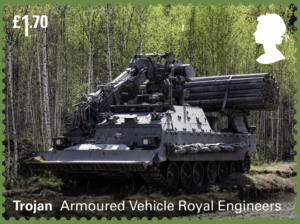 Trojan is an armoured engineer vehicle that is equipped to clear obstacles on the battlefield. It can have a dozer blade or a mine plough fitted to the front, has an excavator arm and can position a fascine – a large bundle of plastic pipes – in a gap to allow other vehicles to cross. It can also tow a trailer-mounted, rocket-propelled mine-clearing system
Trojan is an armoured engineer vehicle that is equipped to clear obstacles on the battlefield. It can have a dozer blade or a mine plough fitted to the front, has an excavator arm and can position a fascine – a large bundle of plastic pipes – in a gap to allow other vehicles to cross. It can also tow a trailer-mounted, rocket-propelled mine-clearing system
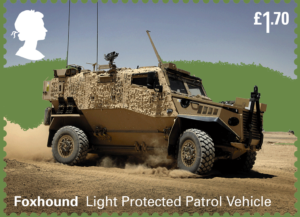 The Foxhound is a lightweight and fast patrol vehicle, with a maximum speed of 70mph. It has a V-shaped hull to channel the blast from mines or improvised explosive devices (IEDs) away from the underside of the vehicle. It has a crew of two and can carry up to four troops in the rear
The Foxhound is a lightweight and fast patrol vehicle, with a maximum speed of 70mph. It has a V-shaped hull to channel the blast from mines or improvised explosive devices (IEDs) away from the underside of the vehicle. It has a crew of two and can carry up to four troops in the rear
Miniature Sheet – Technical Details
Number of stamps: 4
Value of Stamps: 2 x 1st and 2 x £1.70
Design: Studio Up
Acknowledgements: Coyote photo © HOT SHOTS/Alamy Stock Photo; Army Wildcat, Foxhound and Trojan photos: UK MOD © UK Crown copyright 2021; Army logos are trade marks of the UK Secretary of State for Defence and used under licence
Sheet Size: 115mm x 89mm
Stamp Size: 41mm (w) x 30mm (h)
Printer : International Security Printers
Print Process: Lithography
Perforations: 14.5 x 14
Phosphor: Bars as appropriate
Gum: PVA
An authentic Ministry of Defence security hologram is affixed to the back of the envelope.
The First Day Cover is a unique time-limited and personalised collectible which includes all 8 British Army Vehicles stamps postmarked on their first day of issue – 2nd September 2021.
Customise your First Day Cover with your choice of two special edition British Army Vehicles postmarks.
Talents House postmark – Location: Tallents House, Edinburgh, Image: – Features a British army logo.
Alternative postmark – Location: Bovington, Wareham
Bovington is the location of The Tank Museum and, according to David Willey, still is the ‘home of the tank’ for the British Army.
The handstamp features an illustration of tank tracks.
You can even personalise your envelope with a name address of your choice making this an ideal collectible for yourself or a wonderful surprise gift for a friend or relative.
Inside the envelope is an information card with more details about the British Army Vehicles stamp issue
• Includes all eight British Army Vehicles Special Stamps
• Postmarked on the stamps’ first day of issue
• Personalised with name and address of customer’s choice
• Choice of 2 postmark designs
First Day Cover – Miniature Sheet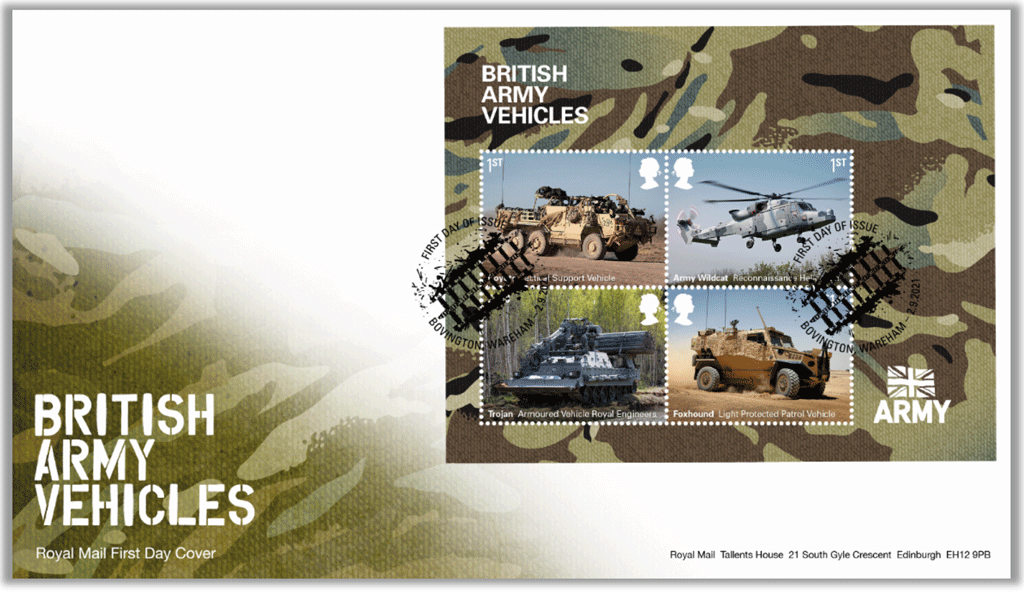
An authentic Ministry of Defence security hologram is affixed to the back of the envelope.
The First Day Cover is a unique time-limited and personalised collectible which includes all 4 British Army Vehicles miniature sheet stamps postmarked on their first day of issue – 2nd September 2021.
Customise your First Day Cover with your choice of two special edition British Army Vehicles postmarks.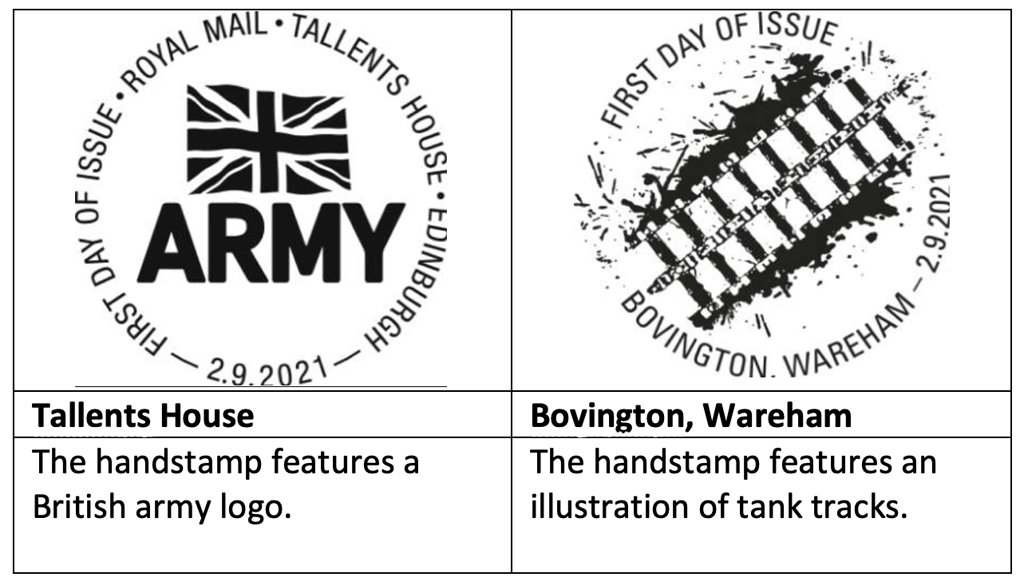
Talents House postmark – Location: Tallents House, Edinburgh. The handstamp features a British army logo.
Alternative postmark – Location: Bovington, Wareham
Bovington is the location of The Tank Museum and, according to David Willey, still is the ‘home of the tank’ for the British Army.
The handstamp features an illustration of tank tracks.
You can even personalise your envelope with a name address of your choice making this an ideal collectible for yourself or a wonderful surprise gift for a friend or relative.
Inside the envelope is an information card with more details about the British Army Vehicles stamp issue.
• Includes all four British Army Vehicles miniature sheet Special Stamps
• Postmarked on the stamps’ first day of issue
• Personalised with name and address of customer’s choice
• Choice of 2 postmark designs
Stamp Souvenirs
The Stamp Souvenir is a non-personalised version of the traditional First Day Cover, meaning it will not have the customer’s name and address printed on the front and will be available on sale for 3 months after the stamp issue date – until 2nd December 2021. The stamps are cancelled with the alternative Bovington, Wareham postmark.
An authentic Ministry of Defence security hologram is affixed to the back of the envelope.
FDC Postmarks
Customers can personalise their First Day cover with a choice of postmarks available. The alternative postmark location represents the Tank Museum in Bovington, Dorset.
An [unserviced] envelope featuring the issue title set against a camouflage pattern
Information Card (Filler Card)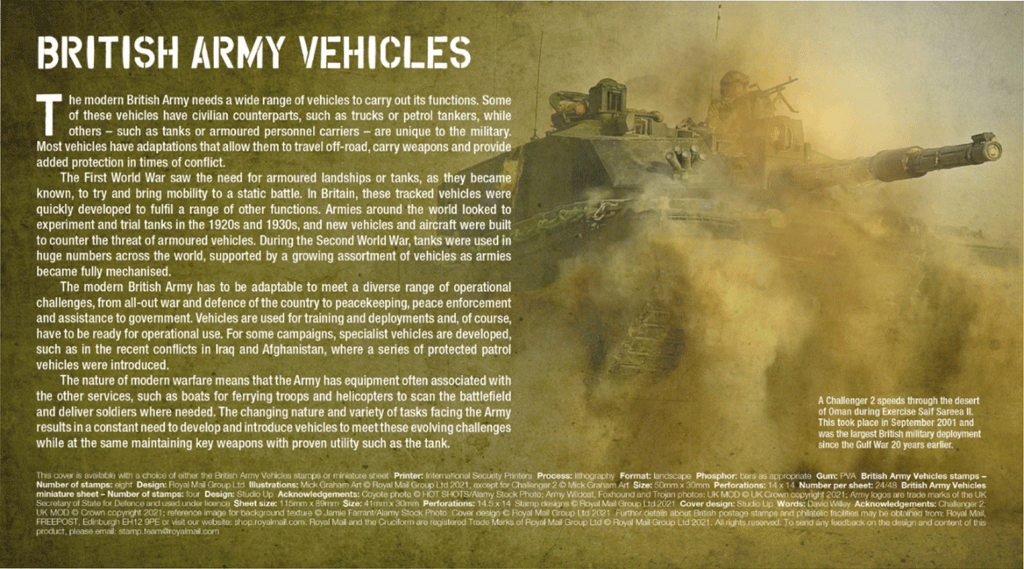 The information card is included inside the First Day Envelope, FDC and Stamp Souvenir and Stamp Sheet Souvenir. It provides a brief overview and specifications for the stamp issue. It was written by David Willey, Curator at the Tank Museum.
The information card is included inside the First Day Envelope, FDC and Stamp Souvenir and Stamp Sheet Souvenir. It provides a brief overview and specifications for the stamp issue. It was written by David Willey, Curator at the Tank Museum.
[press release]
Royal Mail Marks the 70th Anniversary of Beano’s Dennis with a Set of 10 Special Stamps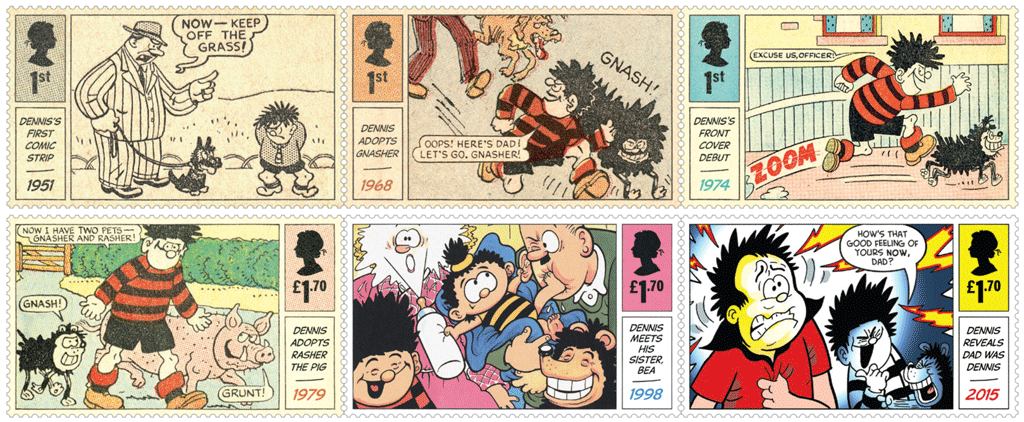
Issue date: July 1
Royal Mail today announced the launch of a new set of stamps celebrating 70 years of the British comic character Dennis.
Six stamps look back at Dennis through the ages; from his first ever black-and-white comic strip in 1951, to important events in his life, including meeting his baby sister, Bea, adopting Gnasher, and even finding out that his dad is a grown-up version of Dennis from the 1980s. These stamps are based on original strips from Beano comics of the time.
A further four stamps, exclusively illustrated by the current Dennis artist, Nigel Parkinson, show the culmination of an exclusive comic strip. The strip, written especially for Royal Mail is featured in the Presentation Pack. The story focuses on Dennis’s birthday celebrations and includes a brief ‘history of Menaces’. The light-hearted episodes end with a birthday surprise, with the final comic strip frame revealing the four new stamps.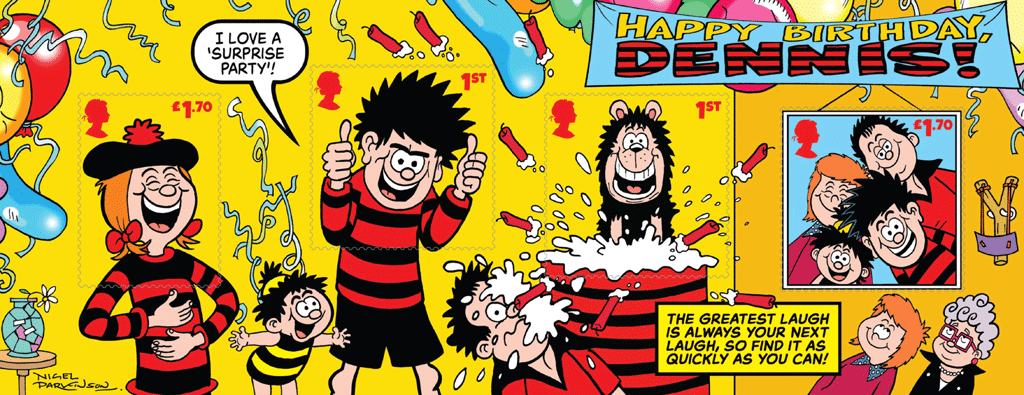
Natasha Ayivor, Royal Mail said: ”For seven decades Dennis has been entertaining children by getting into all manner of mischief and mayhem. Generations have experienced the excitement and anticipation of reading about Dennis’s latest prank. Royal Mail is delighted to be honouring Dennis and Gnasher with a set of stamps as the ultimate birthday present.”
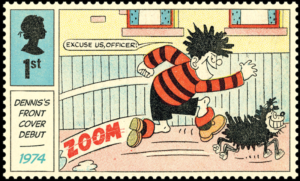 Mike Stirling, Editorial Director of Beano Studios said: “Dennis has stamped his personality across first class laughs and mischief for generations of children. We believe everyone has a little bit of the Dennis spirit within them, so can’t wait for fans big and small to take delivery of this amazing piece of Dennis history. This incredible stamp collection really pushes the envelope of philately flattery for our hero.”
Mike Stirling, Editorial Director of Beano Studios said: “Dennis has stamped his personality across first class laughs and mischief for generations of children. We believe everyone has a little bit of the Dennis spirit within them, so can’t wait for fans big and small to take delivery of this amazing piece of Dennis history. This incredible stamp collection really pushes the envelope of philately flattery for our hero.”
Royal Mail collaborated with Beano Studios on selecting all the stamps and associated imagery featured in the issue.
Dennis through the years:
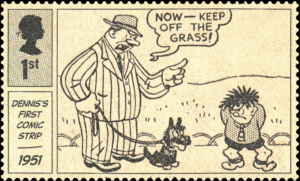 Dennis – ‘the world’s wildest boy’ – was first brought to life in a pencil sketch on the back of a cigarette packet in January 1951. Seventy years later, his mischievous pranks and cheeky grin have not only earned him a place in the hearts of readers of all ages but also ensured that he remains one of Beano’s most famous creations.
Dennis – ‘the world’s wildest boy’ – was first brought to life in a pencil sketch on the back of a cigarette packet in January 1951. Seventy years later, his mischievous pranks and cheeky grin have not only earned him a place in the hearts of readers of all ages but also ensured that he remains one of Beano’s most famous creations.
Dennis made his first appeared in issue no. 452 of Beano, dated 17 March 1951. It would be another few weeks before he donned his legendary red and black striped jumper, but in this half-page strip, illustrated by artist David Law, readers were offered their first glimpse of the cheeky schoolboy in action as he ignored signs to ‘keep off the grass’ at a local park with hilarious results.
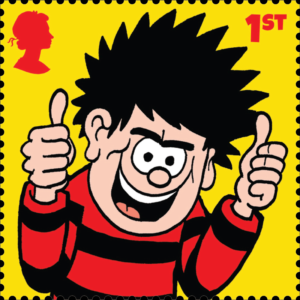 Prior to 1954, Dennis’s strip appeared either in black and white – as per his very first appearance – or supplemented with red, but in February of that year, ‘the world’s wildest boy’ went on his first full-colour adventure on Beano’s back page. Of course, full colour only heightened the mischief, and as Dennis embarked on a day of trainspotting, he not only tricked the train station staff to get onto the platform but ultimately found himself driving the train.
Prior to 1954, Dennis’s strip appeared either in black and white – as per his very first appearance – or supplemented with red, but in February of that year, ‘the world’s wildest boy’ went on his first full-colour adventure on Beano’s back page. Of course, full colour only heightened the mischief, and as Dennis embarked on a day of trainspotting, he not only tricked the train station staff to get onto the platform but ultimately found himself driving the train.
In August 1968, Dennis’s life changed forever when he met a stray Abyssinian wire-haired tripe hound whom he decided to name Gnasher. In the first story featuring the now infamous duo, Gnasher proved that he was just as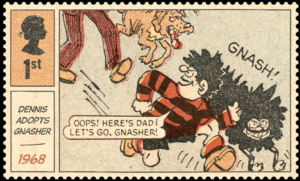 much of a prankster as his human pal when he swiped a bone from one of the ‘pampered pooches’ at a local dog show – and a fight ensued. Gnasher would go on to star in his own strip from 1977.
much of a prankster as his human pal when he swiped a bone from one of the ‘pampered pooches’ at a local dog show – and a fight ensued. Gnasher would go on to star in his own strip from 1977.
After 26 years on the cover of Beano, Biffo the Bear was finally ousted from the front page by Dennis in September 1974. It was a change that had been hinted at two years previously, when Dennis announced his desire to star on the front cover while featuring in a Biffo strip, and it is one that, over the years, has proved incredibly successful – Dennis has appeared on the front cover of almost every issue of the Beano since.
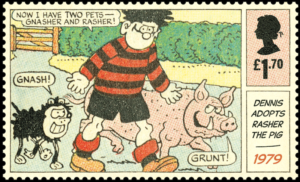 Dennis first met his porcine chum Rasher in May 1979, when he spotted the ‘fine porker’ jumping on his trough at Wurzle Farm. After Dennis agreed to take Rasher off the farmer’s hands, the pig further endeared himself to Dennis when they ran into Walter Brown and he pushed over Dennis’s arch-nemesis, breaking his piggy bank. In 1984, thanks to his popularity with readers, Rasher was given his own strip, which ran regularly in Beano until 1988.
Dennis first met his porcine chum Rasher in May 1979, when he spotted the ‘fine porker’ jumping on his trough at Wurzle Farm. After Dennis agreed to take Rasher off the farmer’s hands, the pig further endeared himself to Dennis when they ran into Walter Brown and he pushed over Dennis’s arch-nemesis, breaking his piggy bank. In 1984, thanks to his popularity with readers, Rasher was given his own strip, which ran regularly in Beano until 1988.
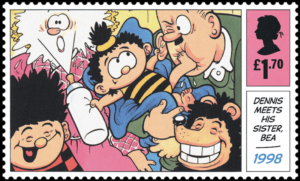 Shortly after Beano celebrated its 60th anniversary in 1998, Dennis’s mum and dad had a big surprise in store for Dennis: his mum was pregnant! In the 19 September issue, Dennis’s little sister – Bea – arrived. Although Dennis was initially hesitant at the prospect of having a girl in the family, it turned out that Bea was not unlike her big brother when it came to causing mischief.
Shortly after Beano celebrated its 60th anniversary in 1998, Dennis’s mum and dad had a big surprise in store for Dennis: his mum was pregnant! In the 19 September issue, Dennis’s little sister – Bea – arrived. Although Dennis was initially hesitant at the prospect of having a girl in the family, it turned out that Bea was not unlike her big brother when it came to causing mischief.
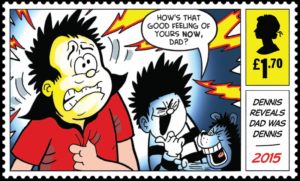 In May 2015, Dennis fans were left gobsmacked when Beano revealed that Dennis’s dad was in fact Dennis 30 years earlier. In the strip, footage was unearthed of Dennis Senior as a boy in which the youngster – dressed as Dennis from older editions of the comic – could be seen engaging in a variety of pranks that, in the present, suitably impressed his young son.
In May 2015, Dennis fans were left gobsmacked when Beano revealed that Dennis’s dad was in fact Dennis 30 years earlier. In the strip, footage was unearthed of Dennis Senior as a boy in which the youngster – dressed as Dennis from older editions of the comic – could be seen engaging in a variety of pranks that, in the present, suitably impressed his young son.
The full set of 10 stamps, available in a Presentation Pack, retails at £13.65. [There are also several different first day covers (one of which is shown below), unserviced cacheted envelopes, a presentation pack, picture postcards and a press sheet. —VSC] 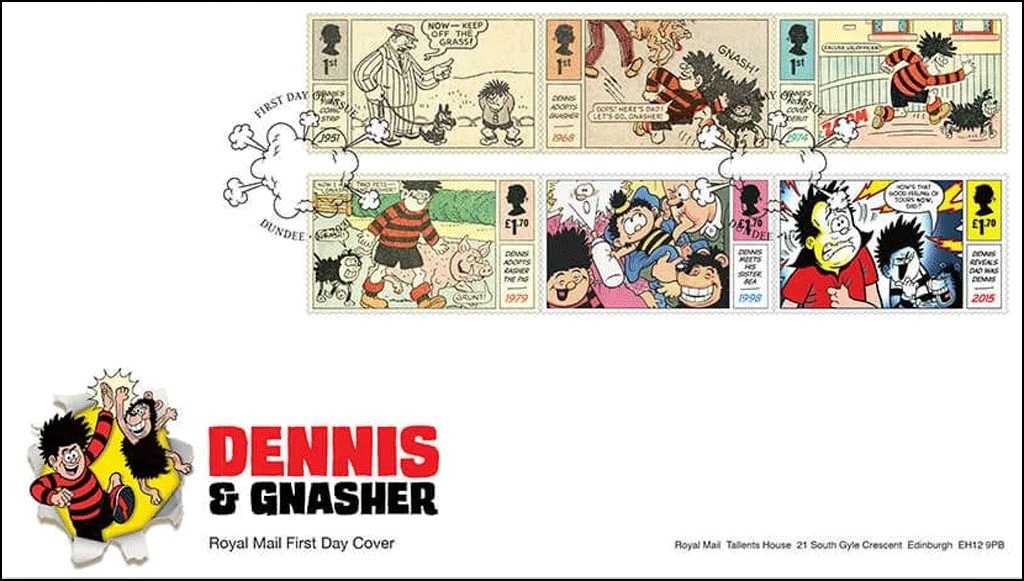 The stamps and range of collectible products are available today (1 July) from www.royalmail.com/dennisandgnasher.
The stamps and range of collectible products are available today (1 July) from www.royalmail.com/dennisandgnasher.
[press release]
In Memoriam
HRH The Prince Philip, Duke Of Edinburgh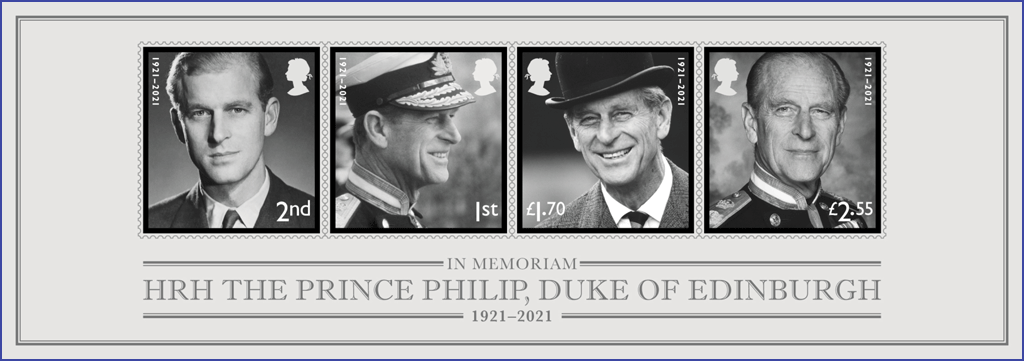
Issue Date: 24 June
Royal Mail has revealed images of four new stamps being issued in memory of HRH The Prince Phillip, Duke of Edinburgh.
The black and white images feature Prince Philip through the years:
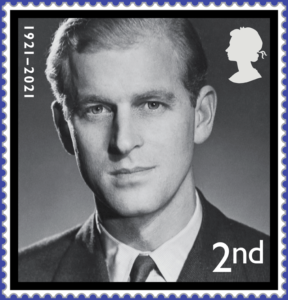 2nd Class stamp: HRH The Prince Philip, Duke of Edinburgh taken by the photographer Baron
2nd Class stamp: HRH The Prince Philip, Duke of Edinburgh taken by the photographer BaronSimon Thompson, CEO, Royal Mail said: ”Throughout adulthood, The Duke of Edinburgh dedicated himself to the service of this country, the Commonwealth and to the many causes he was involved with. For more than seven decades he was at the centre of our national life. His passing is a key moment in our history which we mark with this set of commemorative stamps”.
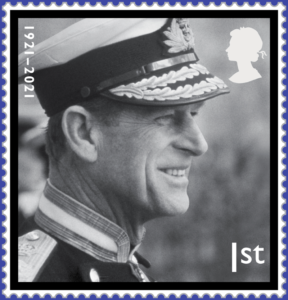 Born on June 1921 in Corfu, Prince Philip of Greece and Denmark was the only son and youngest child of Prince Andrew of Greece and Princess Alice of Battenburg. Like HM The Queen, he was also a great-great-grandchild of Queen Victoria, descended from her second daughter, Princess Alice.
Born on June 1921 in Corfu, Prince Philip of Greece and Denmark was the only son and youngest child of Prince Andrew of Greece and Princess Alice of Battenburg. Like HM The Queen, he was also a great-great-grandchild of Queen Victoria, descended from her second daughter, Princess Alice.
Following the abdication of his uncle, King Constantine I, during a turbulent period in Greece’s history, his family fled the country to exile in France when the Prince was 18 months old.
After education at Cheam Preparatory School and Gordonstoun, in 1939 the 18-year-old Prince joined the Royal Navy as a ‘Special Entry’ Cadet, where he excelled in his training.
In July 1947 the engagement of Lieutenant Philip Mountbatten to Princess Elizabeth was announced, and four months later their wedding at Westminster Abbey was the first great State occasion since the end of World War II.
 On the death of King George VI in February 1952, Prince Philip gave up his naval career to commit himself fully to establishing his role as consort to the new monarch.
On the death of King George VI in February 1952, Prince Philip gave up his naval career to commit himself fully to establishing his role as consort to the new monarch.
In addition to supporting HM The Queen, Prince Philip became patron or president of some 800 organisations during his lifetime, including the Industrial Society, the National Playing Fields Association and the Royal Society for the Encouragement of Arts, Manufactures and Commerce. He was also President of the World Wildlife Fund UK, WWF International President and President Emeritus, Chancellor of Cambridge and Edinburgh Universities, and President of the International Equestrian Federation.
Founding The Duke of Edinburgh’s Award in 1956, HRH inspired and encouraged millions of young people around the world to learn new skills and develop their full potential.
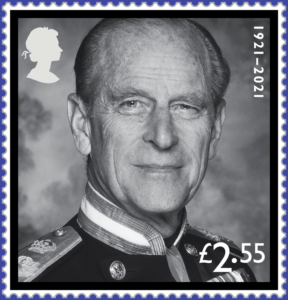 In his spare time, Prince Philip pursued his interests in sports and adventure, becoming a qualified pilot, a keen sailor who competed regularly at the Cowes Regatta and an avid polo player. He also took up four-in-hand carriage-driving and represented Britain at several World and European championships.
In his spare time, Prince Philip pursued his interests in sports and adventure, becoming a qualified pilot, a keen sailor who competed regularly at the Cowes Regatta and an avid polo player. He also took up four-in-hand carriage-driving and represented Britain at several World and European championships.
An artistic individual, The Prince enjoyed painting landscapes and he was a keen collector of art. Prince Philip also played a vital role in helping to modernise the institution of the monarchy. In May 1961, he became the first member of the Royal Family to be interviewed on television. It was his suggestion that The Queen’s Gallery at Buckingham Palace should be built on the site of the chapel destroyed in an air raid in 1940 to display items from the Royal Collection to the public.
During more than half a century in the public eye, Prince Philip accompanied The Queen on more than 250 overseas tours and completed well over 20,000 official engagements. He successfully carved a niche that combined ceremonial and family duties, as the father of four children, with his own crowded itinerary.
The four portrait stamps presented in a miniature sheet, retails at £6.65. The stamps and a range of collectible products are available now to pre-order from www.royalmail.com/dukeofedinburgh.
The stamps will be available on general sale from 24 June 2021.
[press release] [click on any picture for a larger version]
Royal Mail to Honour Paul McCartney with a Set of 12 Special Stamps
Issue date: 28 May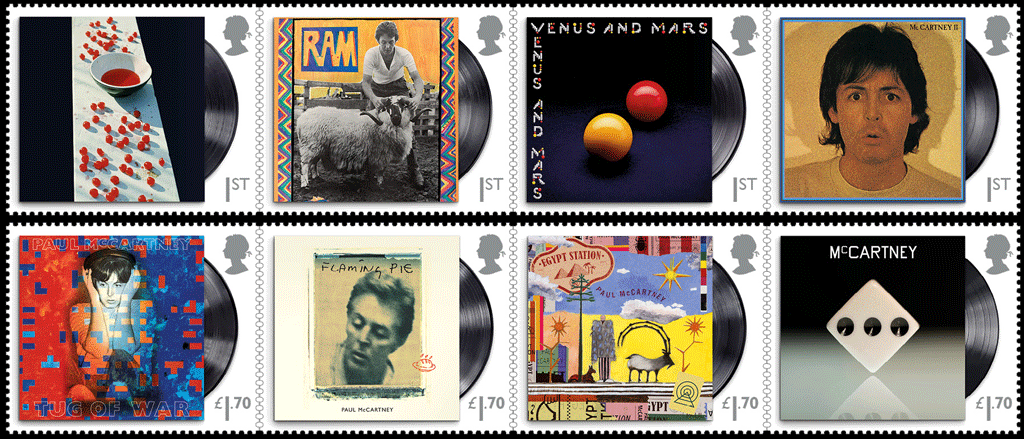
Royal Mail has revealed images of a set of 12 Special Stamps being issued to celebrate one of the UK’s most successful songwriters and greatest music icons, Paul McCartney.
The main stamp set features a selection of eight LPs which have defined Paul McCartney’s career from his first solo album McCartney released in 1970 through to his most recent No.1 album, McCartney III which was recorded and released during lockdown in 2020.
The remaining four stamps, presented in a Miniature Sheet, feature photographs spanning three decades of Paul in the studio, recording for some of the albums featured in the main Special Stamp set.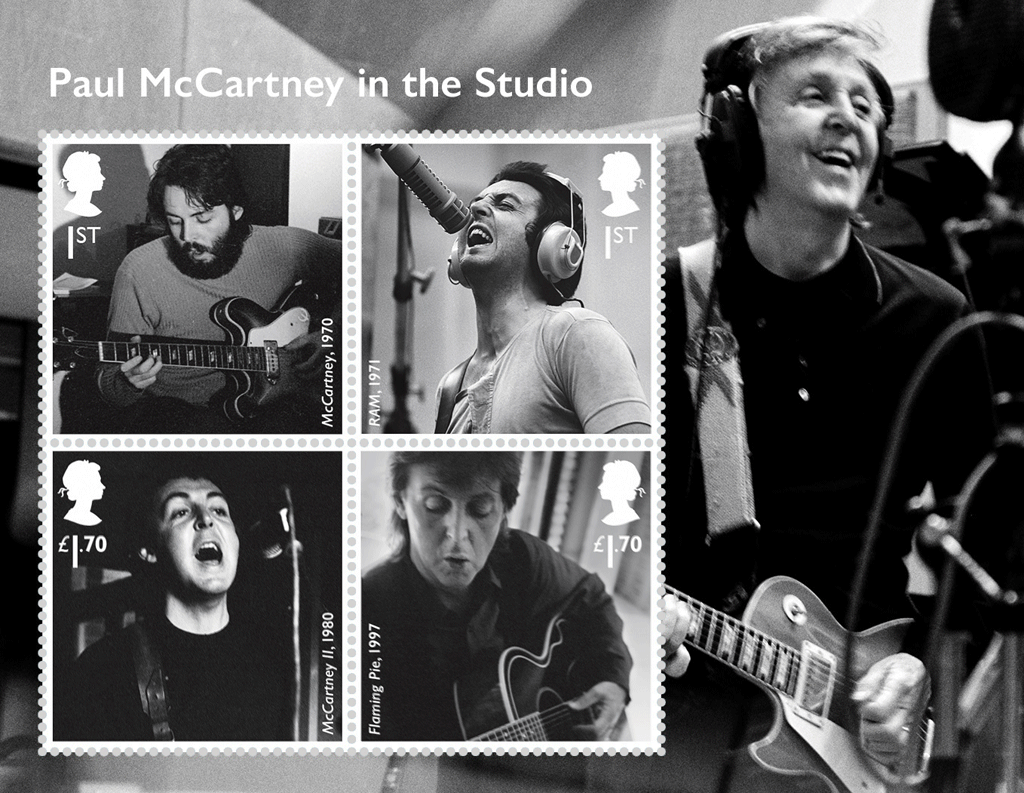
Royal Mail collaborated closely with Paul and his team at MPL Communications Ltd. on the collection – with Paul having personal involvement in the images used and the wider 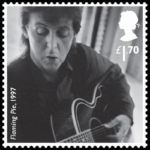 product range created for the issue.
product range created for the issue.
Paul McCartney is an icon of 20th and 21st century popular music. He is recognised by Guinness World Records as ‘the most successful songwriter of all time’ having written or co-written 188 charted records in the UK, of which 91 reached the top 10 and 33 reached No.1. He is the most successful albums act in UK Official Chart history and has been awarded more than 60 gold discs.
In the USA he has composed 32 No.1 singles and is a 21-time Grammy award winner.
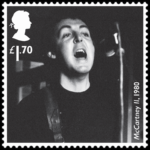 2021 marks the 50th anniversary of the release of RAM, and the formation of the band Wings, which achieved huge success as one of the biggest selling acts of the 70s – with 27 US top 40 hits, and five consecutive No.1 albums.
2021 marks the 50th anniversary of the release of RAM, and the formation of the band Wings, which achieved huge success as one of the biggest selling acts of the 70s – with 27 US top 40 hits, and five consecutive No.1 albums.
The 1977 Wings’ single, Mull of Kintyre, remains one of the UK’s biggest selling non-charity singles.
Paul McCartney is one of only three individual music artists to be featured in a dedicated stamp issue; the others being David Bowie (2017) 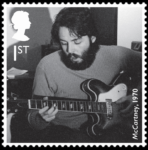 and Elton John (2019).
and Elton John (2019).
David Gold, Royal Mail said: “Paul McCartney remains a vital figure at the centre of rock and pop – an artist whose legacy is immense, but whose work continues to generate popular attention and critical acclaim. This dedicated stamp issue is a fitting tribute to one of the UK’s much loved and revered musical icons.”
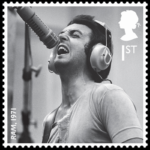 The stamps and a range of collectible products are available for pre-order from 6 May from www.royalmail.com/paulmccartney, by phone on 03457 641 641 and from 7,000 Post Offices throughout the UK. The stamps go on general sale from 28 May priced at £16.20 for the full set.
The stamps and a range of collectible products are available for pre-order from 6 May from www.royalmail.com/paulmccartney, by phone on 03457 641 641 and from 7,000 Post Offices throughout the UK. The stamps go on general sale from 28 May priced at £16.20 for the full set.
The stamps/albums:
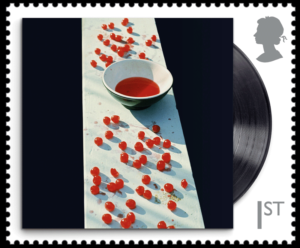 Album: McCartney
Album: McCartney
A clean break from The Beatles and as far from the production extravaganza of their final album Abbey Road as you can get, Paul McCartney’s solo debut was recorded mostly in his living room, with its author playing every instrument.
The sound of a brilliant musical mind throwing out random ideas – and finding they all work – still sounds compelling 50 years on, with its loose patchwork of songs, fragments of songs, instrumentals and experiments.
Album: RAM
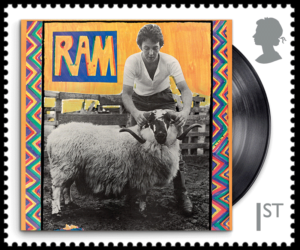 More professionally recorded than McCartney’s debut, RAM nevertheless shared its charming, homespun feel. Credited to Paul and Linda McCartney, RAM took in everything from the gentle, ukulele-driven ‘Ram On’ to the hard-rocking ‘Smile Away’ and the experimental song suite ‘Uncle Albert/Admiral Halsey’, the latter an unexpected US No.1.
More professionally recorded than McCartney’s debut, RAM nevertheless shared its charming, homespun feel. Credited to Paul and Linda McCartney, RAM took in everything from the gentle, ukulele-driven ‘Ram On’ to the hard-rocking ‘Smile Away’ and the experimental song suite ‘Uncle Albert/Admiral Halsey’, the latter an unexpected US No.1.
The closing ‘The Back Seat of My Car’ defines the adjective ‘McCartneyesque’ – impossibly melodically rich, apparently effortless song-writing.
Album: Venus and Mars
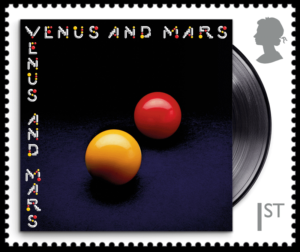 Venus and Mars’s ‘Rock Show’ is a paean to the kind of huge stadium gigs that McCartney’s 1970s band Wings would help pioneer: their ensuing world tour became one of the mid-1970s’ most celebrated musical events. Partly recorded in New Orleans,Venus and Mars captures Wings at their zenith: a supremely polished band operating on the cusp of pop and rock, mixing hits – ‘Listen to What the Man Said’ – with more whimsical ideas, among them a cover of the theme from TV soap Crossroads.
Venus and Mars’s ‘Rock Show’ is a paean to the kind of huge stadium gigs that McCartney’s 1970s band Wings would help pioneer: their ensuing world tour became one of the mid-1970s’ most celebrated musical events. Partly recorded in New Orleans,Venus and Mars captures Wings at their zenith: a supremely polished band operating on the cusp of pop and rock, mixing hits – ‘Listen to What the Man Said’ – with more whimsical ideas, among them a cover of the theme from TV soap Crossroads.
Album: McCartney II
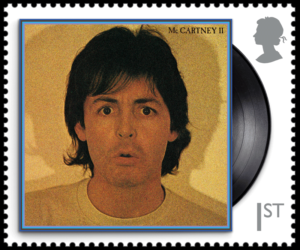 Once more recorded at home and greeted with bafflement on release, McCartney II eventually assumed its rightful place as one of its author’s most celebrated solo albums. McCartney threw himself into experiments, largely driven by synthesisers
Once more recorded at home and greeted with bafflement on release, McCartney II eventually assumed its rightful place as one of its author’s most celebrated solo albums. McCartney threw himself into experiments, largely driven by synthesisers
and drum machines, that ranged from the funky (‘Temporary Secretary’ or ‘Coming Up’) to the flatly bizarre (‘Bogey Music’).
The same sessions produced ‘Wonderful Christmastime’, a perennial favourite of the festive season.
Album: Tug of War
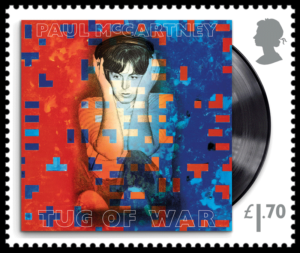 Produced by George Martin after the break-up of Wings, the global chart-topper Tug of War is a song-writing masterclass. ‘Ebony and Ivory’ and ‘Take It Away’ were the big hits and the reflective tribute to the late John Lennon ‘Here Today’ perhaps its most enduring moment, but the album is densely packed with fantastic tracks, the supremely funky Stevie Wonder collaboration ‘What’s That You’re Doing?’ and the gorgeous ballad ‘Wanderlust’ among them.
Produced by George Martin after the break-up of Wings, the global chart-topper Tug of War is a song-writing masterclass. ‘Ebony and Ivory’ and ‘Take It Away’ were the big hits and the reflective tribute to the late John Lennon ‘Here Today’ perhaps its most enduring moment, but the album is densely packed with fantastic tracks, the supremely funky Stevie Wonder collaboration ‘What’s That You’re Doing?’ and the gorgeous ballad ‘Wanderlust’ among them.
Album: Flaming Pie
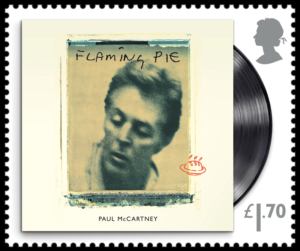 Inspired by the years spent working on The Beatles’ Anthology and mostly co-produced by Jeff Lynne – who had also worked on ‘new’ Beatles songs ‘Free as a Bird’ and ‘Real Love’ – and featuring a rare co-writing credit for Ringo Starr, Flaming Pie saw McCartney strip back his sound, a move that allowed an extremely strong, occasionally understated set of songs to flourish. Poignantly, Flaming Pie is also the last McCartney album to feature the backing vocals of Linda McCartney, who died the following year.
Inspired by the years spent working on The Beatles’ Anthology and mostly co-produced by Jeff Lynne – who had also worked on ‘new’ Beatles songs ‘Free as a Bird’ and ‘Real Love’ – and featuring a rare co-writing credit for Ringo Starr, Flaming Pie saw McCartney strip back his sound, a move that allowed an extremely strong, occasionally understated set of songs to flourish. Poignantly, Flaming Pie is also the last McCartney album to feature the backing vocals of Linda McCartney, who died the following year.
Album: Egypt Station
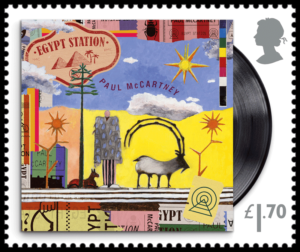 In 2018, Paul McCartney unexpectedly teamed up with Adele producer Greg Kurstin and – on ‘Fuh You’ – blue-chip pop songwriter Ryan Tedder. But Egypt Station is not a straightforward lunge for latter-day pop contemporaneity: it is an impressively varied album, which switches between the raucous stomp of ‘Come on to Me’, the troubled, reflective ‘I Don’t Know’ and ‘Hunt You Down/Naked/C-Link’, the latest in a long line of McCartney tracks that segue different song fragments together in a thrillingly episodic whole.
In 2018, Paul McCartney unexpectedly teamed up with Adele producer Greg Kurstin and – on ‘Fuh You’ – blue-chip pop songwriter Ryan Tedder. But Egypt Station is not a straightforward lunge for latter-day pop contemporaneity: it is an impressively varied album, which switches between the raucous stomp of ‘Come on to Me’, the troubled, reflective ‘I Don’t Know’ and ‘Hunt You Down/Naked/C-Link’, the latest in a long line of McCartney tracks that segue different song fragments together in a thrillingly episodic whole.
Album: McCartney III
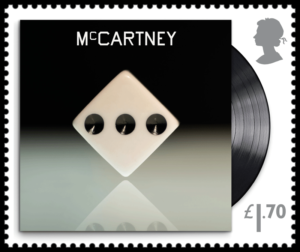 Inspired by the circumstances of lockdown to return to the home-studio, one-man-band approach of the previous albums in the McCartney series, McCartney III unexpectedly appeared at the end of 2020, a critically lauded collection of songs that ranged from acoustic ballads to tough rock and roll. The experimental spirit of its predecessors in the McCartney series was underlined by its lengthy instrumental opener, ‘Long Tailed Winter Bird’, and the powerful, episodic eight minutes of ‘Deep Deep Feeling’.
Inspired by the circumstances of lockdown to return to the home-studio, one-man-band approach of the previous albums in the McCartney series, McCartney III unexpectedly appeared at the end of 2020, a critically lauded collection of songs that ranged from acoustic ballads to tough rock and roll. The experimental spirit of its predecessors in the McCartney series was underlined by its lengthy instrumental opener, ‘Long Tailed Winter Bird’, and the powerful, episodic eight minutes of ‘Deep Deep Feeling’.
[press release] [click any picture for a larger version]
Royal Mail Reveals New Stamps Being Issued To Mark The Key Battle In The Wars Of The Roses – 550th Anniversary Of The Battle Of Tewkesbury Issue date: May 4, 2021
Issue date: May 4, 2021
Royal Mail has revealed a set of eight stamps being issued to mark the 550th anniversary of the Battle of Tewkesbury, one of the defining battles of the Wars of the Roses.
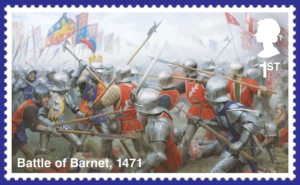 The illustrations are by Graham Turner, a leading medieval and military artist. The stamps feature stunning artwork, re-imagining eight key battles across the years of the Wars.
The illustrations are by Graham Turner, a leading medieval and military artist. The stamps feature stunning artwork, re-imagining eight key battles across the years of the Wars.
Royal Mail also worked with writer, historian and researcher, Dr David Grummitt on the stamp issue.
It can be argued that the Wars of the Roses, due largely to the history plays of William Shakespeare, is one of the best known, if least understood, periods of English history.
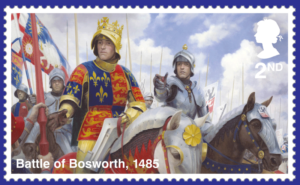 The Wars of the Roses were fought between the two rival cadet branches of the royal House of Plantagenet: the House of Lancaster and the House of York, and were named – many years later – after the supposed emblems of the contending parties: the white rose of York and the red rose of Lancaster.
The Wars of the Roses were fought between the two rival cadet branches of the royal House of Plantagenet: the House of Lancaster and the House of York, and were named – many years later – after the supposed emblems of the contending parties: the white rose of York and the red rose of Lancaster.
The second half of the 15th century saw a series of violent struggles for the throne. The period 1455–87 witnessed the deposition of three kings, and the violent death of two of them, in a series of bloody battles 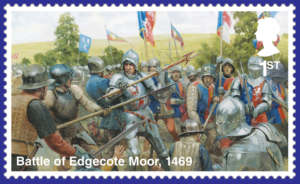 that engaged all ranks of society.
that engaged all ranks of society.
Following the English defeat to France in the Hundred Years War, rival nobles struggled for control of the weak king, Henry VI. This led to a bloody skirmish in 1455 with sustained fighting from 1459.
The following year, Richard, Duke of York, laid claim to the throne. Although he was killed in battle in 1460, his son, Edward, took up the Yorkist cause, defeating the Lancastrians at the Battle of Towton a few months 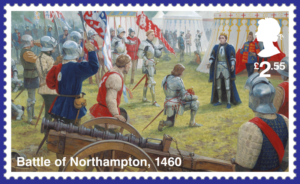 later.
later.
As Edward IV, he ruled until a rebellion led by his cousin, Warwick the Kingmaker, ended in his deposition in 1470 in favour of Henry VI. Returning the following year, Edward defeated and killed Warwick and captured Henry VI, who was later executed.
After more than a decade of peace, Edward’s untimely death in 1483 led to the usurpation of the throne by his brother, Richard III. Richard’s reign was cut short by another usurper, 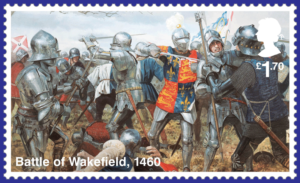 Henry Tudor, at the Battle of Bosworth in 1485.
Henry Tudor, at the Battle of Bosworth in 1485.
David Gold, Royal Mail, said: “The Wars of the Roses fascinated both Shakespeare and historians alike. These striking illustrations bring to life a period of British history that was steeped in drama, betrayal and a quest for power that still enthrals today.”
Stamp-by-Stamp:
Battle of Bosworth, 1485
King Richard III marshals his men before his final, heroic charge on 22 August 1485.
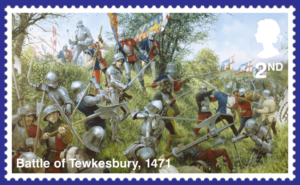 Battle of Tewkesbury, 1471
Battle of Tewkesbury, 1471
Exactly 550 years ago, on 4 May 1471, the Yorkist King Edward IV leads his men forward after a failed Lancastrian attack on his flank.
Battle of Barnet, 1471
On Easter Sunday 1471, Edward IV leads his army into battle, defeating and killing Warwick the Kingmaker.
Battle of Edgecote Moor, 1469
The Yorkist knight Sir Richard Herbert shows his prowess fighting on the front line against rebel forces on 26 July 1469.
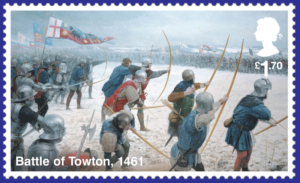 Battle of Towton, 1461
Battle of Towton, 1461
On Palm Sunday 1461, the Yorkist archers, using the weather to their advantage, fire volleys of arrows into the advancing Lancastrians.
Battle of Wakefield, 1460
On 30 December 1460, the sons of the Lancastrian lords killed at St Albans five years earlier cut down Richard, Duke of York.
Battle of Northampton, 1460
Edward, Earl of March, the future Edward IV, proclaims his loyalty to Henry VI after the Yorkist victory on 10 July 1460.
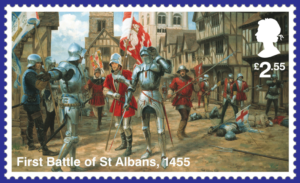 First Battle of St Albans, 1455
First Battle of St Albans, 1455
On 22 May 1455, the streets of St Albans see the first blows of the Wars of the Roses when the Duke of York and his allies attack the royal party.
The full set of eight stamps, available in a Presentation Pack, retails at £12.40. The stamps and a range of collectible products are available now to pre-order Royal Mail website here.
[press release]
Royal Mail Celebrates Science Fiction Classics from British Authors On Six Specially Commissioned Stamp Illustrations
Royal Mail has revealed images of original artworks being issued to celebrate six classic science fiction novels by British writers.
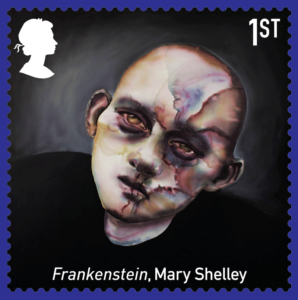 The specially commissioned illustrations feature striking interpretations of the classics and depict key moments in the evolution of the genre.
The specially commissioned illustrations feature striking interpretations of the classics and depict key moments in the evolution of the genre.
The stamps are issued in the year that marks the 75th anniversary of the death of HG Wells and the 70th anniversary of the publication of John Wyndham’s The Day of the Triffids.
The classic novels and illustrators featured in the set are:
There are many stories that can point to the origins of science fiction. The satirical author Lucian, writing during the 2nd century, imagined a trip to the moon in his True History. In 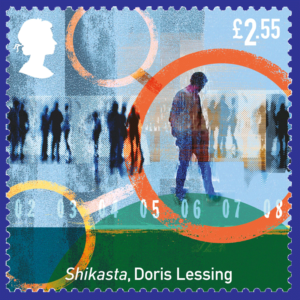 1516, Thomas More proposed an ideal society, an alternative Britain, that he called Utopia. But modern science fiction is the product of societies that were undergoing rapid technological change, where the scientific world view had an authority to rival theological explanations and where there was a large, literate population that could support new forms of mass culture. These conditions were met in 19th-century Britain, but the term ‘science fiction’ came into general usage only at the end of the 1920s.
1516, Thomas More proposed an ideal society, an alternative Britain, that he called Utopia. But modern science fiction is the product of societies that were undergoing rapid technological change, where the scientific world view had an authority to rival theological explanations and where there was a large, literate population that could support new forms of mass culture. These conditions were met in 19th-century Britain, but the term ‘science fiction’ came into general usage only at the end of the 1920s.
When Mary Shelley reworked the Gothic romance to address the advances of contemporary science in her 1818 novel Frankenstein, a new literary genre was born.
From the beginning, Britain has been at the forefront of science fiction writing, and the writers whose work is featured on these stamps are household names the world over.
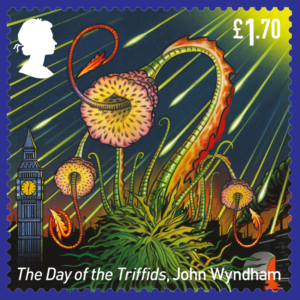 While science fiction can often be considered as a lowly form of culture, full of bug-eyed monsters in flying saucers, it is also a genre that can have ambitions to engage at the highest level with emergent scientific conceptions and technologies.
While science fiction can often be considered as a lowly form of culture, full of bug-eyed monsters in flying saucers, it is also a genre that can have ambitions to engage at the highest level with emergent scientific conceptions and technologies.
There is a strong British tradition of writers who reach for these sublime heights, which this stamp issue celebrates.
Royal Mail also worked with British writer and academic, Roger Luckhurst, on the stamp issue. Roger is a Professor in Modern and Contemporary Literature in the Department of English and Humanities at Birkbeck, University of London and was Distinguished Visiting Professor at Columbia University in 2016.
The full set of six stamps, available in a Presentation Pack, retails at £11.10. The stamps and a range of collectible products are available now to pre-order from www.royalmail.com/classicsciencefiction.
The stamps will go on general sale from 15 April 2021.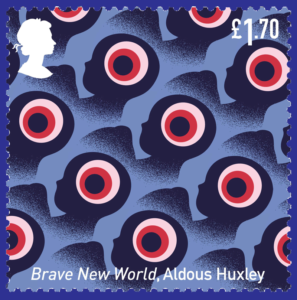
Stamp-By-Stamp
Mary Shelley (1797–1851) The daughter of radicals, Shelley wrote her most famous book when she was just 19, in a famous ghost-story competition with Percy Shelley and Lord Byron. Frankenstein switched the Gothic romance from religious terror to secular scientific horror.
HG Wells (1866–1946) A young writer from the first generation of those with formal scientific training, Wells jumped into the new journals and magazines of the 1890s and helped fashion the British ‘scientific romance’ in his disturbing exploration of futures near and far.
Aldous Huxley (1894–1963) Huxley was a satirical novelist who, in horrified reaction to Wells’s outline of scientific utopia, created in Brave New World one of the most enduring novels of dystopia. He explores a future where technology oppresses rather than liberates humanity.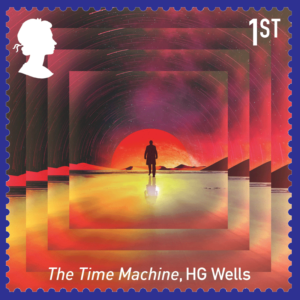
John Wyndham (1903–69) Wyndham captured the anxious and diminished state of England after 1945. The Day of the Triffids creates a catastrophe and then explores various ways of living in the ruins. This book was a major influence on what became known as post-apocalyptic fiction.
Arthur C Clarke (1917–2008) In ecstatic visions of expansion into outer space and evolutionary leaps for humanity, Clarke combined a longing for  transcendence with an interest in the mechanics of technology. This strand is often termed ‘hard SF’, for extrapolating possible futures from known science.
transcendence with an interest in the mechanics of technology. This strand is often termed ‘hard SF’, for extrapolating possible futures from known science.
Doris Lessing (1919–2013) A hugely versatile novelist, Lessing turned to science fiction in the 1970s to explore questions of gender, colonisation and power. Women have always been involved in science fiction, but Lessing’s generation gave the genre new avenues of social criticism.


